- [email protected]
- Marriage Certificates
- Formal Award Certificates
- Award of Honor
- Best Performance Award
- Best Teacher Award
- Certificate of Appreciation
- Certificate of Completion
- Certificate of Excellence
- Certificate of Participation
- Graduation Certificates
- Scholarship Certificates
- Sports Award Certificates
- Teacher of the Year Awards
- Halloween Award Certificates
- Years of Service Award Certificates
- Gift Vouchers
- New Year Gift Certificates
- Spa & Saloon
- Thanksgiving
- Retirement Certificates
- Sip & See
- Announcement Invitation
- Gender Reveal
- Baby Sitting
- Halloween Party Flyer
- Autumn / Fall Party
- New Year’s Party
- Thanksgiving Dinner
- Valentine’s Day
- Harvest Festival
- Birthday Party
- Casual Party
- Pajama Party
- Holiday Party
- Sip & Shop
- Halloween Party
- Chinese New Year
- Christmas Party
- New Year Party
- Rosh Hashanah
- St Patricks day
- Anniversary Banquet Tickets
- Art Expo Event Tickets
- Baby Shower Raffle Tickets
- Barbeque Raffle Tickets
- Beer Event Drink Tickets
- Beer Festival Tickets
- Boxing Tickets
- Cartoon Movie Tickets
- Charitable Sports Event Tickets
- Christmas Tickets
- Circus Birthday Tickets
- Concert Event Tickets
- Diaper Raffle Tickets
- Education Raffle Tickets
- Food Festival Tickets
- Golf Tickets
- Gospel Fest Concert Ticket
- Graduation Raffle Tickets
- Gymnastic Event Tickets
- Halloween Tickets
- Movie Tickets
- Multi Purpose Retro Ticket
- Pool Party Event Tickets
- Realistic Event Tickets
- Tour Raffle Tickets
- Train Tickets
- Travel Tickets
- Vintage Event Ticket
- Halloween Menu Templates
- Halloween Bottle Labels
- Business Letterheads
- Architecture Letterheads
- Auto Repair Letterheads
- Barbershop Letterheads
- Catering Letterheads
- Construction Company Letterheads
- Doctor’s Letterheads
- Education Letterheads
- Farm Letterheads
- House Cleaning Service Letterheads
- Legal Services Letterheads
- Logistic Services Letterheads
- Medical Clinic Letterhead
- Personal Letterheads
- Photographer Letterheads
- Restaurant Letterheads

38+ Biography Templates with Images – Download in Word & PDF
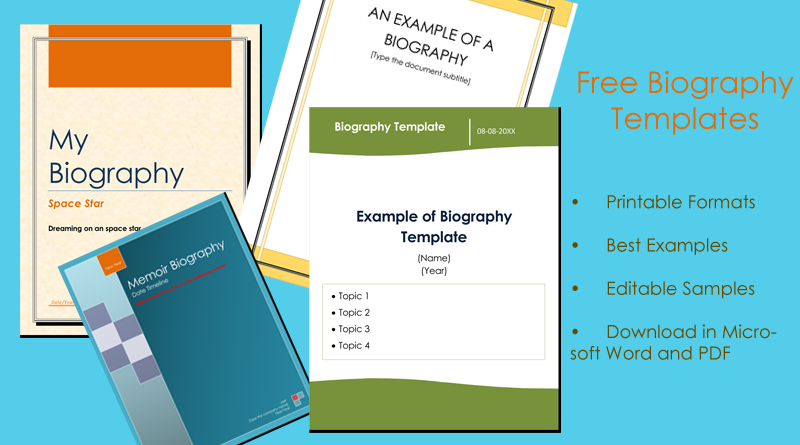
Experts in various fields are often more than capable of excelling in the arts and sciences, business and sports. However, for some individuals, no matter how affluent they are in their area of expertise, they have a tough time talking about themselves. This makes writing an author’s biography strangely difficult for some people. In today’s world, a biography may be written by another person, or by the individual themselves, such as when an individual need to self-promote themselves on a Kickstarter, website, or self-promote their book. Whatever the reason, biography templates are used for that purpose. These templates can be used for personal or professional endeavors, from authors, business people, athletes and those in the arts and sciences.
Biography templates are an absolute must for any author. Writers need to connect to their fan base, they need to intrigue people, they must present an interesting image of themselves in the world to assist people in becoming familiar with their works. These templates will usually include, but not be limited to: Author’s name, interests, any awards, released and/or upcoming books, collaborations, publishers, where they live and work, along with a website url. Biography templates guide you in knowing what to leave in and what to leave out of the biography.
We are providing up to 15 different biography templates available for immediate use. All of these biography templates are beautifully done and professionally designed in order to create a perfectly written biography. These templates come with gorgeous page designs and border designs. Using our templates, you’ll have no problem filling in the information you need, as all of our templates have fields for you to insert your information, including the imagery of your choice. Our templates are easy to use, just customize, and either save to file or print. Using our beautifully designed templates will assure that your biographies will appear professional and receive the acknowledgement they deserve.
Biography Templates for Microsoft Word
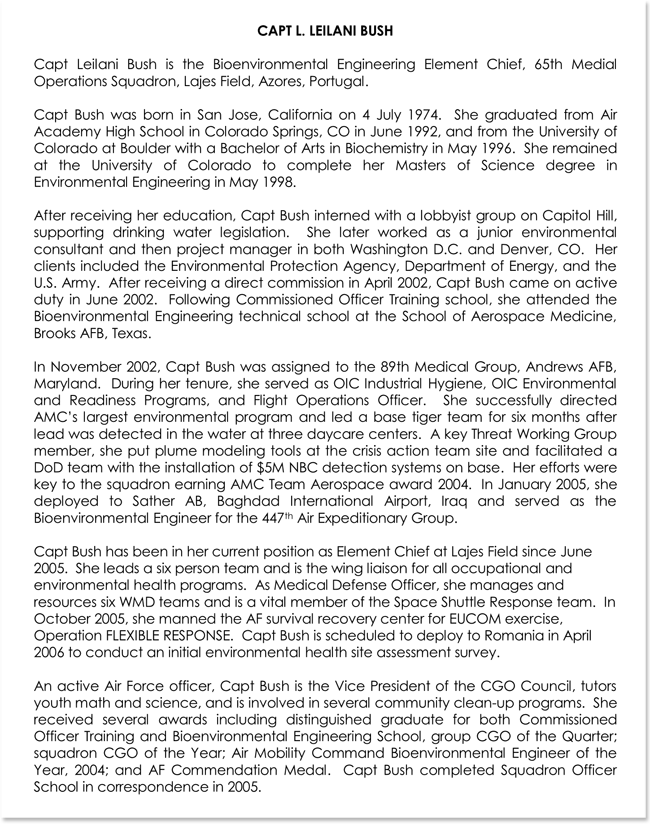
Personal Biography Template
Faculty biography template.
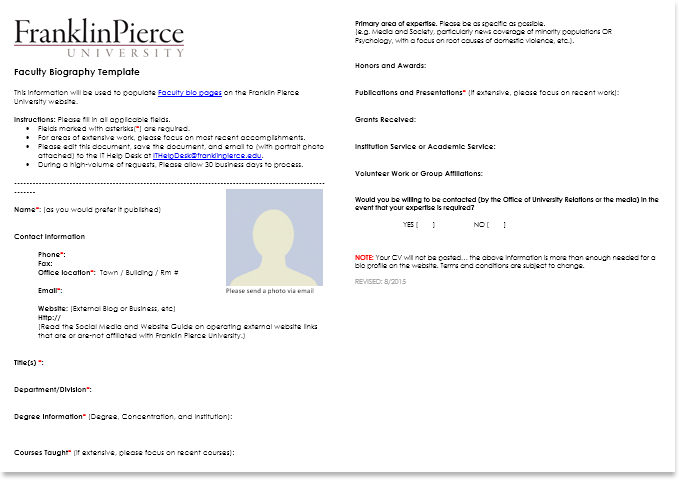
Biography Examples
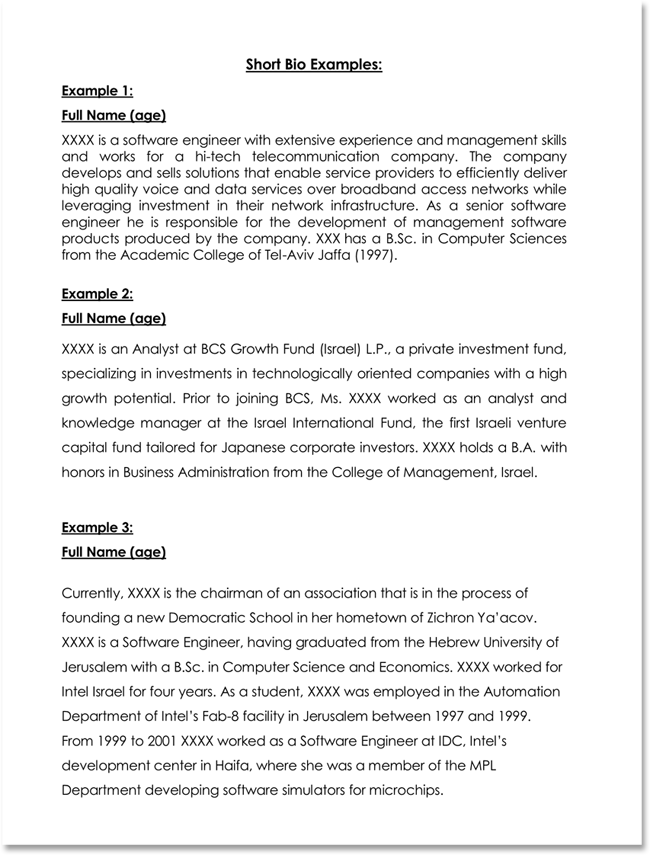
We hope these templates and samples will help you writing your own bio with style and professionalism. Thank you for coming on our site. We hope to see you again.
Share this post
Related posts.
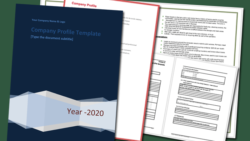
Company Profile Sample Templates – Create a Professional Profile
It is important for you to be able to share information about your company when you need to, and you...

Board Resolution Templates – 4+ Samples for Word and PDF
A board resolution is a legal document that records the decisions made by your company's board of directors. But why...
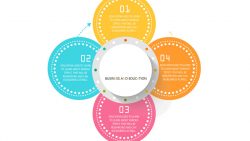
Free Venn Diagram Templates (12+ Printable Venn Diagrams)
A Venn diagram is a design/illustration of the relationship between and among sets or group of objects that have something...

8 Best Templates to Analysis Stakeholders (Word, Excel, PowerPoint, and PDF)
Stakeholder analysis is the first step in managing stakeholders, which successful people use to support each other. Stakeholder management helps...
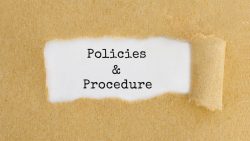
Policy and Procedure Templates for Word and PDF
Even though "policies" and "procedures" are two terms frequently mentioned together, they serve entirely different roles. Policies refer to the...

Beautiful Marriage Certificate Templates to Try This Season
Marriage is one of the major life-changing events in anyone’s life. As it is an official occasion, a marriage certificate...

7 Ways to Improve Website UX/UI Design in 2022
User Experience (UX) and User Interaction (UI) are essential elements in designing a website. A good UX/UI indicates how efficiently...
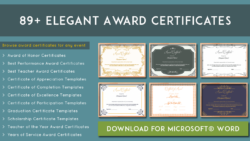
89+ Elegant Award Certificate Templates for Business and School Events
When an individual works hard to stand out from the crowd, to be the best they can be in a...

Free Call Log Templates to Keep Track your Calls
Call logging is the process of collecting, evaluating, and reporting technical and statistical data to derive useful meaning from it....
5+ Free Personal Biography Examples & Templates for MS Word
Download templates in ms word format.
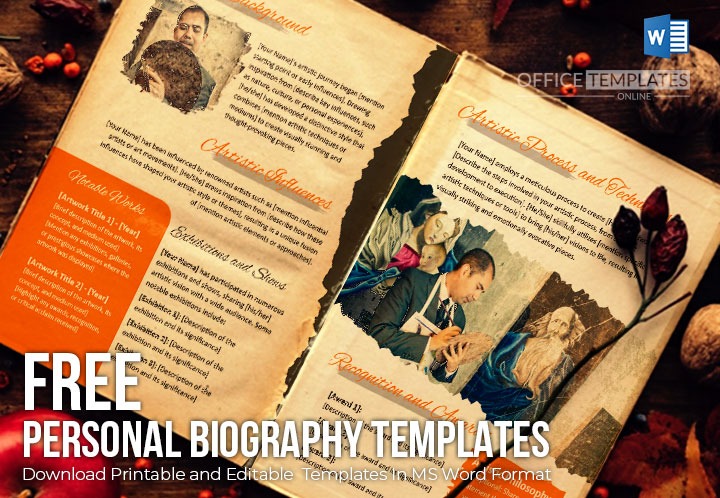
#1 – One Page Biography Example
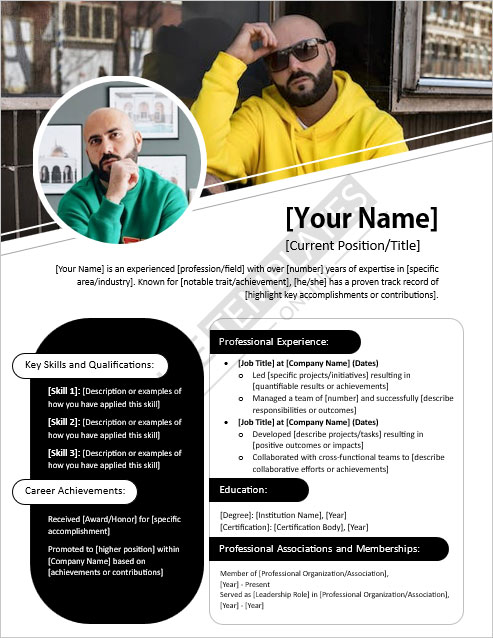
#2 – Two-Page Example for Authors & Writers
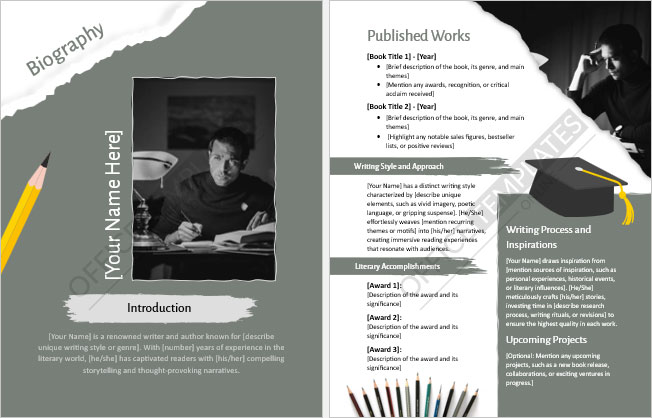
#3 – Multipage Entrepreneur Biography Example: Your Journey to Business Success
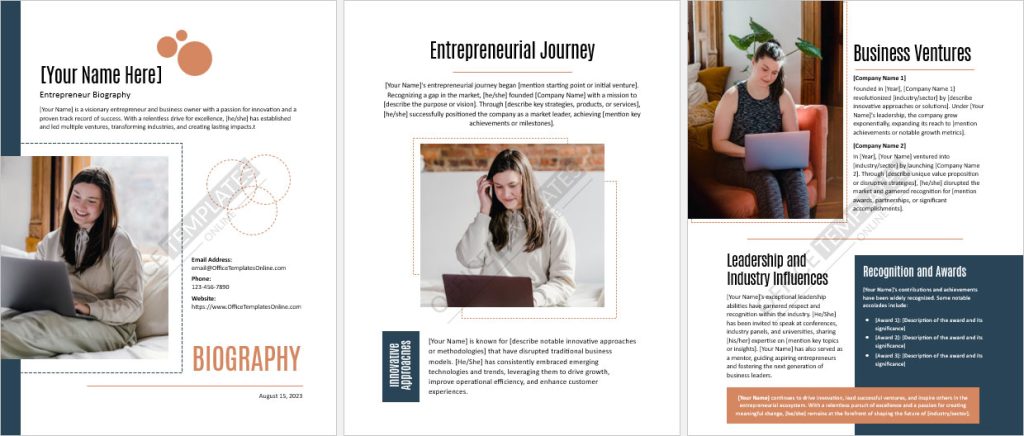
#4 – Three-Page Artist Biography: Unleash Your Creative Journey
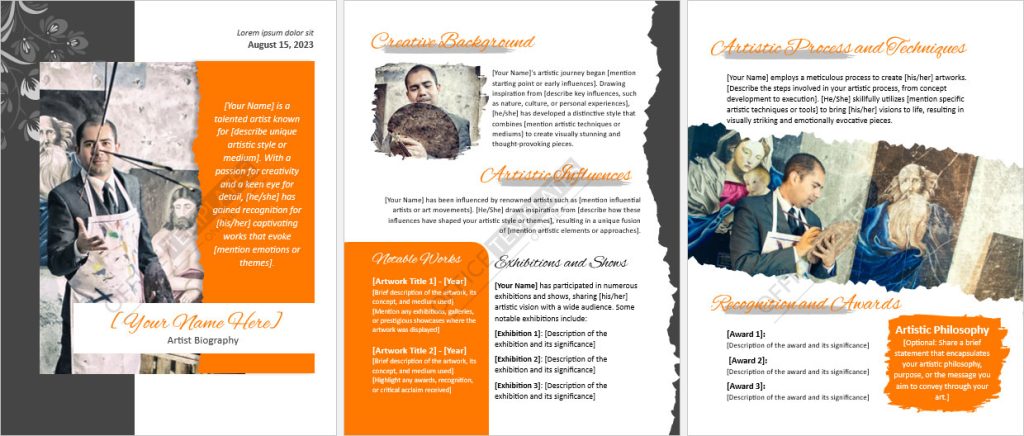
#5 – Student Biography Example Template with Cover and Sub-pages: Unveil Your Educational Journey
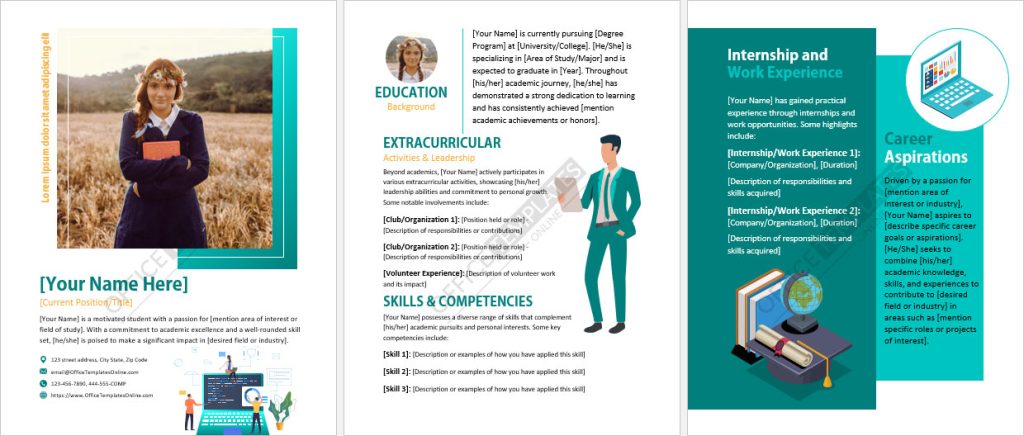
What is a Personal Biography?
How is a personal biography written, what does the outline of a personal biography look like.
- Your name: Include your full name as the first element in the personal biography. This establishes your identity and serves as an introduction.
- Your parent’s details or family details (if any): Optionally, you can include brief information about your parents or family background to provide context or showcase any notable familial connections.
- Your place of birth or living (if that’s something you would want to add in): If relevant, mention your place of birth or current place of residence. This adds a personal touch and helps readers connect with your background.
- Your education early at school: Highlight your educational journey during your early schooling years, including notable schools attended, academic achievements, or any significant experiences during this period.
- Your education later in life: Outline your educational pursuits beyond the early school years, such as higher education, specialized training, certifications, or any notable degrees earned.
- Your childhood interests: Share the interests or hobbies you pursued during your childhood, which might have influenced your personal or professional development.
- Your job titles: List the job titles or roles you have held throughout your career, emphasizing positions of significance or relevance to your field or industry.
- Your interests and hobbies: Highlight your current interests and hobbies, demonstrating a well-rounded personality and providing insight into your passions outside of work or studies.
- Your awards and achievements: Enumerate any notable awards, honors, or achievements you have received in your personal, academic, or professional life. This showcases your accomplishments and areas of excellence.
- Your academic and professional past: Provide an overview of your academic and professional history, including key milestones, notable projects, or experiences that have shaped your journey.
- Your plans for the future: Discuss your aspirations and goals for the future, such as career objectives, educational pursuits, or personal ambitions. This highlights your drive and motivation.
- Your ultimate passion: Identify and describe your ultimate passion, whether it is a specific cause, creative endeavor, or professional pursuit that truly fuels your enthusiasm.
- Things that govern your life: Briefly mention the guiding principles, values, or beliefs that influence your decisions and actions in life, showcasing your personal philosophy or ethics.
- Things you want to achieve in life: Share your broader life goals or aspirations, beyond specific career objectives, expressing the impact you hope to make or the legacy you want to leave.
Things to Avoid in a Personal Biography
- Don’t stretch unimportant details too much, focus on the catchy stuff only (no one is interested in why you shifted from one apartment to another to another unless the details are compelling)
- Don’t stick to the dates so much (did the subject buy his first piano on the fifth of June or on the eighth?! Let us help: No one cares!)
- Never makeup stuff that you are unsure about, do your research well
- Don’t forget to add emotions to your biography. Who would want to read your life’s chronological order of events?! Make it interesting!
- Avoid excessive self-promotion or bragging. Instead, focus on presenting your accomplishments in a humble and genuine manner.
- Avoid using jargon or technical terms that may not be easily understood by the general audience. Keep your language accessible and engaging.
- Don’t overlook proofreading and editing. Ensure your biography is free from grammatical errors, typos, or formatting issues that may distract readers.
- Avoid including irrelevant or outdated information. Keep your biography focused on recent and relevant experiences, skills, and achievements.
- Don’t forget to tailor your biography to the specific audience or purpose. Adapt your content to resonate with the readers and align with the goals of the biography.
Writing an Attention-Grabbing Personal Biography: Examples and Guidance
Infusing your biography with unique qualities and values.
- Embrace Your Uniqueness: Highlight your authentic self. Identify your unique qualities, experiences, and perspectives that set you apart from others. Showcase your individuality and allow it to shine through your writing. Emphasize what makes you special and valuable to your target audience.
- Define Your Personal Values: Clearly articulate your core values and beliefs. By expressing your values in your biography, you demonstrate integrity and establish a connection with like-minded individuals or organizations. Align your values with your desired career path and emphasize them as a guiding force in your life and decision-making.
- Showcase Your Expertise and Strengths: Identify your areas of expertise and strengths, and showcase them in a good way. Highlight specific achievements, projects, or experiences that demonstrate your competence and skills. By presenting yourself as an expert in your field, you differentiate yourself and position yourself as a go-to resource.
- Tell Your Compelling Story: Craft a narrative that tells your unique story. Share personal anecdotes or turning points in your life that have shaped your journey. By sharing your challenges, triumphs, and lessons learned, you create an emotional connection with your readers. This storytelling aspect adds depth and authenticity to your personal brand.
- Consistency Across Platforms: Ensure consistency across your online presence and offline interactions. Align your biography with your social media profiles, personal website, and other professional platforms. Maintain a cohesive brand message and visual identity that reinforces your unique value proposition.
- Cultivate a Professional Image: Consider how you present yourself visually in your personal biography. Use professional photos and design elements that reflect your personal brand. Create a visually appealing layout that resonates with your target audience and reinforces your desired image.
Helpful Video Tutorials

← Previous Article
Next Article →
You may also like

- Doctor Prescription Pad Formats
- Printable ID Cards
- Creative Resume Formats for Freshers
- Modern Resume Templates
- Best Cover Page Formats
- Printable Report Cards
- Business Proposal Templates
- 22 Raffle Ticket Templates
- Free Certificate Templates
Search the database of 10,000+ templates, designs & formats for Microsoft Office.
- Say Goodbye with Style: Free Impactful Resignation Letter Templates
- Share Your Appreciation: Free Memorial Day Card Templates
- Crafted with Love: Free Mother’s Day Cards to Warm Mom’s Heart
- Stand Out from the Crowd: 6+ Free Fact Sheet Templates
- Make Your Mark: Free Printable Dog Name Tags for Every Tail-Wagger!
- 7+ Free Stunning Easter Templates for Joyful Celebrations
- 9+ Free Admit-One Ticket Templates: Flexible and Easy to Edit
- Get Cooking with Style: 8+ Free Customizable Recipe Card Templates
- 11+ Free Mortgage Flyer Templates to Elevate Your Marketing
- Enhance Your Events with 20+ Unique and Free Ticket Voucher Templates
- Relaxation Redefined: Explore Free 8+ Spa Voucher Templates
- 24+ Free Employment Verification Letter Templates
- Certificates
- Cover Pages
- Educational
- Event Templates
- Invoices & Receipts
- Letterheads
- Office Related
- Personal Use
- 137+ Professional Reports – MS Word & Excel
- 70+ Printable & Editable ID Card Designs
- 59+ Proposal Formats
- 31+ Best Flyer Designs & Formats
- 100+ Cover Page Templates
- 22+ Free Letterhead Designs and Formats
- 24+ Free Resume Designs & for Freshers and Professionals
- 136+ Printable Certificate Templates
- 55+ Quotations & Invoices
- Create FREE PDF Calendar Online
- PRO Courses Guides New Tech Help Pro Expert Videos About wikiHow Pro Upgrade Sign In
- EDIT Edit this Article
- EXPLORE Tech Help Pro About Us Random Article Quizzes Request a New Article Community Dashboard This Or That Game Popular Categories Arts and Entertainment Artwork Books Movies Computers and Electronics Computers Phone Skills Technology Hacks Health Men's Health Mental Health Women's Health Relationships Dating Love Relationship Issues Hobbies and Crafts Crafts Drawing Games Education & Communication Communication Skills Personal Development Studying Personal Care and Style Fashion Hair Care Personal Hygiene Youth Personal Care School Stuff Dating All Categories Arts and Entertainment Finance and Business Home and Garden Relationship Quizzes Cars & Other Vehicles Food and Entertaining Personal Care and Style Sports and Fitness Computers and Electronics Health Pets and Animals Travel Education & Communication Hobbies and Crafts Philosophy and Religion Work World Family Life Holidays and Traditions Relationships Youth
- Browse Articles
- Learn Something New
- Quizzes Hot
- This Or That Game
- Train Your Brain
- Explore More
- Support wikiHow
- About wikiHow
- Log in / Sign up
- Education and Communications
How to Write a Biography
Last Updated: May 28, 2024 Fact Checked
This article was co-authored by Stephanie Wong Ken, MFA . Stephanie Wong Ken is a writer based in Canada. Stephanie's writing has appeared in Joyland, Catapult, Pithead Chapel, Cosmonaut's Avenue, and other publications. She holds an MFA in Fiction and Creative Writing from Portland State University. This article has been fact-checked, ensuring the accuracy of any cited facts and confirming the authority of its sources. This article has been viewed 1,863,358 times.
Writing a biography can be a fun challenge, where you are sharing the story of someone’s life with readers. You may need to write a biography for a class or decide to write one as a personal project. Once you have identified the subject of the biography, do your research so you know as much about them as possible. Then, dive into the writing of the biography and revising it until it is at its finest.
Researching Your Subject

- If the subject does not give you permission to write the biography, you may want to choose a different subject. If you decide to publish the biography without the subject’s permission, you may be susceptible to legal action by the subject.
- If the subject is no longer alive, you obviously do not need to ask permission to write about them.

- You may create research questions to help focus your research of the subject, such as, What do I find interesting about the subject? Why is this subject important to readers? What can I say that is new about the subject? What would I like to learn more about?

- For in person interviews, record them with a tape recorder or a voice recorder on your computer or phone.
- You may need to interview the subject and others several times to get the material you need.

- You may also want to visit areas where the subject made a major decision or breakthrough in their life. Being physically in the area can give you a sense of how the subject might have felt and help you write their experiences more effectively.

- When researching the time period ask yourself: What were the social norms of that time? What was going on economically and politically? How did the social and political climate affect the subject?

- You may also include historical events or moments that affected the subject on the timeline. For example, maybe there was a conflict or civil war that happened during the person’s life that affected their life.
Writing the Biography

- You may end up focusing on particular areas of the person’s life. If you do this, work through a particular period in the person’s life chronologically.

- For example, you may have a thesis statement about focusing on how the person impacted the civil rights movement in America in the 1970s. You can then make sure all your content relates back to this thesis.

- Flashbacks should feel as detailed and real as present day scenes. Use your research notes and interviews with the subject to get a good sense of their past for the flashbacks.
- For example, you may jump from the person’s death in the present to a flashback to their favorite childhood memory.

- For example, you may focus on the person’s accomplishments in the civil rights movement. You may write a whole section about their contributions and participation in major civil rights marches in their hometown.

- For example, you may notice that the person’s life is patterned with moments of adversity, where the person worked hard and fought against larger forces. You can then use the theme of overcoming adversity in the biography.

- For example, you may note how you see parallels in the person’s life during the civil rights movement with your own interests in social justice. You may also commend the person for their hard work and positive impact on society.
Polishing the Biography

- Revise the biography based on feedback from others. Do not be afraid to cut or edit down the biography to suit the needs of your readers.

- Having a biography riddled with spelling, grammar, and punctuation errors can turn off your readers and result in a poor grade if you are handing in the text for a class.

- If the biography is for a class, use MLA , APA , or Chicago Style citations based on the preferences of your instructor.
Biography Help

Community Q&A
- Be careful when publishing private or embarrassing information, especially if the person is not a celebrity. You may violate their "Right of Privacy" or equivalent. Thanks Helpful 31 Not Helpful 5
- Have the sources to back up your statements about the subject's life. Untruthful written statements can lead to litigation. If it is your opinion, be clear that it is such and not fact (although you can support your opinion with facts). Thanks Helpful 16 Not Helpful 15

You Might Also Like

- ↑ https://grammar.yourdictionary.com/writing/how-to-write-a-biography.html
- ↑ https://au.indeed.com/career-advice/career-development/how-to-write-a-bio
- ↑ https://www.writersdigest.com/writing-articles/3-tips-for-writing-successful-flashbacks
- ↑ https://www.grammarly.com/blog/how-to-write-bio/
- ↑ https://writingcenter.unc.edu/tips-and-tools/editing-and-proofreading/
- ↑ https://www.plagiarism.org/article/how-do-i-cite-sources
About This Article

Before you write a biography, gather as much information about the subject that you can from sources like newspaper articles, interviews, photos, existing biographies, and anything else you can find. Write the story of that person’s life, including as much supporting detail as you can, including information about the place and time where the person lived. Focus on major events and milestones in their life, including historical events, marriage, children, and events which would shape their path later in life. For tips from our reviewer on proofreading the biography and citing your sources, keep reading! Did this summary help you? Yes No
- Send fan mail to authors
Reader Success Stories
Jan 24, 2021
Did this article help you?

Janis Hendrick
Oct 10, 2018
Teresa Bradley
Sep 15, 2020
Apr 18, 2016
Latanya Foster
Apr 26, 2016

Featured Articles

Trending Articles

Watch Articles

- Terms of Use
- Privacy Policy
- Do Not Sell or Share My Info
- Not Selling Info
wikiHow Tech Help Pro:
Level up your tech skills and stay ahead of the curve
TRY OUR FREE APP
Write your book in Reedsy Studio. Try the beloved writing app for free today.
Craft your masterpiece in Reedsy Studio
Plan, write, edit, and format your book in our free app made for authors.

Blog • Perfecting your Craft
Posted on Jun 30, 2023
How to Write a Biography: A 7-Step Guide [+Template]
From time to time, nonfiction authors become so captivated by a particular figure from either the present or the past, that they feel compelled to write an entire book about their life. Whether casting them as heroes or villains, there is an interesting quality in their humanity that compels these authors to revisit their life paths and write their story.
However, portraying someone’s life on paper in a comprehensive and engaging way requires solid preparation. If you’re looking to write a biography yourself, in this post we’ll share a step-by-step blueprint that you can follow.
How to write a biography:
1. Seek permission when possible
2. research your subject thoroughly, 3. do interviews and visit locations, 4. organize your findings, 5. identify a central thesis, 6. write it using narrative elements, 7. get feedback and polish the text.

FREE RESOURCE
Biography Outline Template
Craft a satisfying story arc for your biography with our free template.
While you technically don’t need permission to write about public figures (or deceased ones), that doesn't guarantee their legal team won't pursue legal action against you. Author Kitty Kelley was sued by Frank Sinatra before she even started to write His Way , a biography that paints Ol Blue Eyes in a controversial light. (Kelley ended up winning the lawsuit, however).

Whenever feasible, advise the subject’s representatives of your intentions. If all goes according to plan, you’ll get a green light to proceed, or potentially an offer to collaborate. It's a matter of common sense; if someone were to write a book about you, you would likely want to know about it well prior to publication. So, make a sincere effort to reach out to their PR staff to negotiate an agreement or at least a mutual understanding of the scope of your project.
At the same time, make sure that you still retain editorial control over the project, and not end up writing a puff piece that treats its protagonist like a saint or hero. No biography can ever be entirely objective, but you should always strive for a portrayal that closely aligns with facts and reality.
If you can’t get an answer from your subject, or you’re asked not to proceed forward, you can still accept the potential repercussions and write an unauthorized biography . The “rebellious act” of publishing without consent indeed makes for great marketing, though it’ll likely bring more headaches with it too.
✋ Please note that, like other nonfiction books, if you intend to release your biography with a publishing house , you can put together a book proposal to send to them before you even write the book. If they like it enough, they might pay you an advance to write it.

Book Proposal Template
Craft a professional pitch for your nonfiction book with our handy template.
Once you’ve settled (or not) the permission part, it’s time to dive deep into your character’s story.
Deep and thorough research skills are the cornerstone of every biographer worth their salt. To paint a vivid and accurate portrait of someone's life, you’ll have to gather qualitative information from a wide range of reliable sources.
Start with the information already available, from books on your subject to archival documents, then collect new ones firsthand by interviewing people or traveling to locations.
Browse the web and library archives

Put your researcher hat on and start consuming any piece on your subject you can find, from their Wikipedia page to news articles, interviews, TV and radio appearances, YouTube videos, podcasts, books, magazines, and any other media outlets they may have been featured in.
Establish a system to orderly collect the information you find 一 even seemingly insignificant details can prove valuable during the writing process, so be sure to save them.
Depending on their era, you may find most of the information readily available online, or you may need to search through university libraries for older references.

For his landmark biography of Alexander Hamilton, Ron Chernow spent untold hours at Columbia University’s library , reading through the Hamilton family papers, visiting the New York Historical Society, as well as interviewing the archivist of the New York Stock Exchange, and so on. The research process took years, but it certainly paid off. Chernow discovered that Hamilton created the first five securities originally traded on Wall Street. This finding, among others, revealed his significant contributions to shaping the current American financial and political systems, a legacy previously often overshadowed by other founding fathers. Today Alexander Hamilton is one of the best-selling biographies of all time, and it has become a cultural phenomenon with its own dedicated musical.
Besides reading documents about your subject, research can help you understand the world that your subject lived in.
Try to understand their time and social environment
Many biographies show how their protagonists have had a profound impact on society through their philosophical, artistic, or scientific contributions. But at the same time, it’s worth it as a biographer to make an effort to understand how their societal and historical context influenced their life’s path and work.
An interesting example is Stephen Greenblatt’s Will in the World . Finding himself limited by a lack of verified detail surrounding William Shakespeare's personal life, Greenblatt, instead, employs literary interpretation and imaginative reenactments to transport readers back to the Elizabethan era. The result is a vivid (though speculative) depiction of the playwright's life, enriching our understanding of his world.

Many readers enjoy biographies that transport them to a time and place, so exploring a historical period through the lens of a character can be entertaining in its own right. The Diary of Samuel Pepys became a classic not because people were enthralled by his life as an administrator, but rather from his meticulous and vivid documentation of everyday existence during the Restoration period.
Once you’ve gotten your hands on as many secondary sources as you can find, you’ll want to go hunting for stories first-hand from people who are (or were) close to your subject.
With all the material you’ve been through, by now you should already have a pretty good picture of your protagonist. But you’ll surely have some curiosities and missing dots in their character arc to figure out, which you can only get by interviewing primary sources.
Interview friends and associates
This part is more relevant if your subject is contemporary, and you can actually meet up or call with relatives, friends, colleagues, business partners, neighbors, or any other person related to them.
In writing the popular biography of Steve Jobs, Walter Isaacson interviewed more than one hundred people, including Jobs’s family, colleagues, former college mates, business rivals, and the man himself.
🔍 Read other biographies to get a sense of what makes a great one. Check out our list of the 30 best biographies of all time , or take our 30-second quiz below for tips on which one you should read next.
Which biography should you read next?
Discover the perfect biography for you. Takes 30 seconds!
When you conduct your interviews, make sure to record them with high quality audio you can revisit later. Then use tools like Otter.ai or Descript to transcribe them 一 it’ll save you countless hours.
You can approach the interview with a specific set of questions, or follow your curiosity blindly, trying to uncover revealing stories and anecdotes about your subject. Whatever your method, author and biography editor Tom Bromley suggests that every interviewer arrives prepared, "Show that you’ve done your work. This will help to put the interviewee at ease, and get their best answers.”
Bromley also places emphasis on the order in which you conduct interviews. “You may want to interview different members of the family or friends first, to get their perspective on something, and then go directly to the main interviewee. You'll be able to use that knowledge to ask sharper, more specific questions.”
Finally, consider how much time you have with each interviewee. If you only have a 30-minute phone call with an important person, make it count by asking directly the most pressing questions you have. And, if you find a reliable source who is also particularly willing to help, conduct several interviews and ask them, if appropriate, to write a foreword as part of the book’s front matter .
Sometimes an important part of the process is packing your bags, getting on a plane, and personally visiting significant places in your character’s journey.
Visit significant places in their life
A place, whether that’s a city, a rural house, or a bodhi tree, can carry a particular energy that you can only truly experience by being there. In putting the pieces together about someone’s life, it may be useful to go visit where they grew up, or where other significant events of their lives happened. It will be easier to imagine what they experienced, and better tell their story.
In researching The Lost City of Z , author David Grann embarked on a trek through the Amazon, retracing the steps of British explorer Percy Fawcett. This led Grann to develop new theories about the circumstances surrounding the explorer's disappearance.

Hopefully, you won’t have to deal with jaguars and anacondas to better understand your subject’s environment, but try to walk into their shoes as much as possible.
Once you’ve researched your character enough, it’s time to put together all the puzzle pieces you collected so far.
Take the bulk of notes, media, and other documents you’ve collected, and start to give them some order and structure. A simple way to do this is by creating a timeline.
Create a chronological timeline
It helps to organize your notes chronologically 一 from childhood to the senior years, line up the most significant events of your subject’s life, including dates, places, names and other relevant bits.

You should be able to divide their life into distinct periods, each with their unique events and significance. Based on that, you can start drafting an outline of the narrative you want to create.
Draft a story outline
Since a biography entails writing about a person’s entire life, it will have a beginning, a middle, and an end. You can pick where you want to end the story, depending on how consequential the last years of your subject were. But the nature of the work will give you a starting character arc to work with.
To outline the story then, you could turn to the popular Three-Act Structure , which divides the narrative in three main parts. In a nutshell, you’ll want to make sure to have the following:
- Act 1. Setup : Introduce the protagonist's background and the turning points that set them on a path to achieve a goal.
- Act 2. Confrontation : Describe the challenges they encounter, both internal and external, and how they rise to them. Then..
- Act 3. Resolution : Reach a climactic point in their story in which they succeed (or fail), showing how they (and the world around them) have changed as a result.
Only one question remains before you begin writing: what will be the main focus of your biography?
Think about why you’re so drawn to your subject to dedicate years of your life to recounting their own. What aspect of their life do you want to highlight? Is it their evil nature, artistic genius, or visionary mindset? And what evidence have you got to back that up? Find a central thesis or focus to weave as the main thread throughout your narrative.

Or find a unique angle
If you don’t have a particular theme to explore, finding a distinct angle on your subject’s story can also help you distinguish your work from other biographies or existing works on the same subject.
Plenty of biographies have been published about The Beatles 一 many of which have different focuses and approaches:
- Philip Norman's Shout is sometimes regarded as leaning more towards a pro-Lennon and anti-McCartney stance, offering insights into the band's inner dynamics.
- Ian McDonald's Revolution in the Head closely examines their music track by track, shifting the focus back to McCartney as a primary creative force.
- Craig Brown's One Two Three Four aims to capture their story through anecdotes, fan letters, diary entries, and interviews.
- Mark Lewisohn's monumental three-volume biography, Tune In , stands as a testament to over a decade of meticulous research, chronicling every intricate detail of the Beatles' journey.

Finally, consider that biographies are often more than recounting the life of a person. Similar to how Dickens’ Great Expectations is not solely about a boy named Pip (but an examination and critique of Britain’s fickle, unforgiving class system), a biography should strive to illuminate a broader truth — be it social, political, or human — beyond the immediate subject of the book.
Once you’ve identified your main focus or angle, it’s time to write a great story.

While biographies are often highly informative, they do not have to be dry and purely expository in nature . You can play with storytelling elements to make it an engaging read.
You could do that by thoroughly detailing the setting of the story , depicting the people involved in the story as fully-fledged characters , or using rising action and building to a climax when describing a particularly significant milestone of the subject’s life.
One common way to make a biography interesting to read is starting on a strong foot…
Hook the reader from the start
Just because you're honoring your character's whole life doesn't mean you have to begin when they said their first word. Starting from the middle or end of their life can be more captivating as it introduces conflicts and stakes that shaped their journey.
When he wrote about Christopher McCandless in Into the Wild , author Jon Krakauer didn’t open his subject’s childhood and abusive family environment. Instead, the book begins with McCandless hitchhiking his way into the wilderness, and subsequently being discovered dead in an abandoned bus. By starting in medias res , Krakauer hooks the reader’s interest, before tracing back the causes and motivations that led McCandless to die alone in that bus in the first place.

You can bend the timeline to improve the reader’s reading experience throughout the rest of the story too…
Play with flashback
While biographies tend to follow a chronological narrative, you can use flashbacks to tell brief stories or anecdotes when appropriate. For example, if you were telling the story of footballer Lionel Messi, before the climax of winning the World Cup with Argentina, you could recall when he was just 13 years old, giving an interview to a local newspaper, expressing his lifelong dream of playing for the national team.
Used sparsely and intentionally, flashbacks can add more context to the story and keep the narrative interesting. Just like including dialogue does…
Reimagine conversations
Recreating conversations that your subject had with people around them is another effective way to color the story. Dialogue helps the reader imagine the story like a movie, providing a deeper sensory experience.

One thing is trying to articulate the root of Steve Jobs’ obsession with product design, another would be to quote his father , teaching him how to build a fence when he was young: “You've got to make the back of the fence just as good looking as the front of the fence. Even though nobody will see it, you will know. And that will show that you're dedicated to making something perfect.”
Unlike memoirs and autobiographies, in which the author tells the story from their personal viewpoint and enjoys greater freedom to recall conversations, biographies require a commitment to facts. So, when recreating dialogue, try to quote directly from reliable sources like personal diaries, emails, and text messages. You could also use your interview scripts as an alternative to dialogue. As Tom Bromley suggests, “If you talk with a good amount of people, you can try to tell the story from their perspective, interweaving different segments and quoting the interviewees directly.”

FREE COURSE
How to Write Believable Dialogue
Master the art of dialogue in 10 five-minute lessons.
These are just some of the story elements you can use to make your biography more compelling. Once you’ve finished your manuscript, it’s a good idea to ask for feedback.
If you’re going to self-publish your biography, you’ll have to polish it to professional standards. After leaving your work to rest for a while, look at it with fresh eyes and self-edit your manuscript eliminating passive voice, filler words, and redundant adverbs.

Then, have a professional editor give you a general assessment. They’ll look at the structure and shape of your manuscript and tell you which parts need to be expanded on or cut. As someone who edited and commissioned several biographies, Tom Bromley points out that a professional “will look at the sources used and assess whether they back up the points made, or if more are needed. They would also look for context, and whether or not more background information is needed for the reader to understand the story fully. And they might check your facts, too.”
In addition to structural editing, you may want to have someone copy-edit and proofread your work.

MEET EDITORS
Polish your book with expert help
Sign up, meet 1500+ experienced editors, and find your perfect match.
Importantly, make sure to include a bibliography with a list of all the interviews, documents, and sources used in the writing process. You’ll have to compile it according to a manual of style, but you can easily create one by using tools like EasyBib . Once the text is nicely polished and typeset in your writing software , you can prepare for the publication process.
In conclusion, by mixing storytelling elements with diligent research, you’ll be able to breathe life into a powerful biography that immerses readers in another individual’s life experience. Whether that’ll spark inspiration or controversy, remember you could have an important role in shaping their legacy 一 and that’s something not to take lightly.
Continue reading
Recommended posts from the Reedsy Blog

What is the Climax of a Story? Examples & Tips
The climax is perhaps a story's most crucial moment, but many writers struggle to stick the landing. Let's see what makes for a great story climax.

What is Tone in Literature? Definition & Examples
We show you, with supporting examples, how tone in literature influences readers' emotions and perceptions of a text.

Writing Cozy Mysteries: 7 Essential Tips & Tropes
We show you how to write a compelling cozy mystery with advice from published authors and supporting examples from literature.

Man vs Nature: The Most Compelling Conflict in Writing
What is man vs nature? Learn all about this timeless conflict with examples of man vs nature in books, television, and film.

The Redemption Arc: Definition, Examples, and Writing Tips
Learn what it takes to redeem a character with these examples and writing tips.

How Many Sentences Are in a Paragraph?
From fiction to nonfiction works, the length of a paragraph varies depending on its purpose. Here's everything you need to know.
Join a community of over 1 million authors
Reedsy is more than just a blog. Become a member today to discover how we can help you publish a beautiful book.

We made a writing app for you
Yes, you! Write. Format. Export for ebook and print. 100% free, always.

1 million authors trust the professionals on Reedsy. Come meet them.
Enter your email or get started with a social account:
All Formats
- Microsoft Office
Word Templates
38+ biography templates – doc, pdf, excel.
So you are about to make that really big conference presentation in front of loads of people who barely know you. It is at times like this that you’d need that short and simple biography that will help the audiences know just who you are so that they can connect with your presentation well. You can compose biographies about veterans in military forces (e.g., air force, navy), ministry executives in government, personal trainers in fitness, physicians in medical fields, and much more.
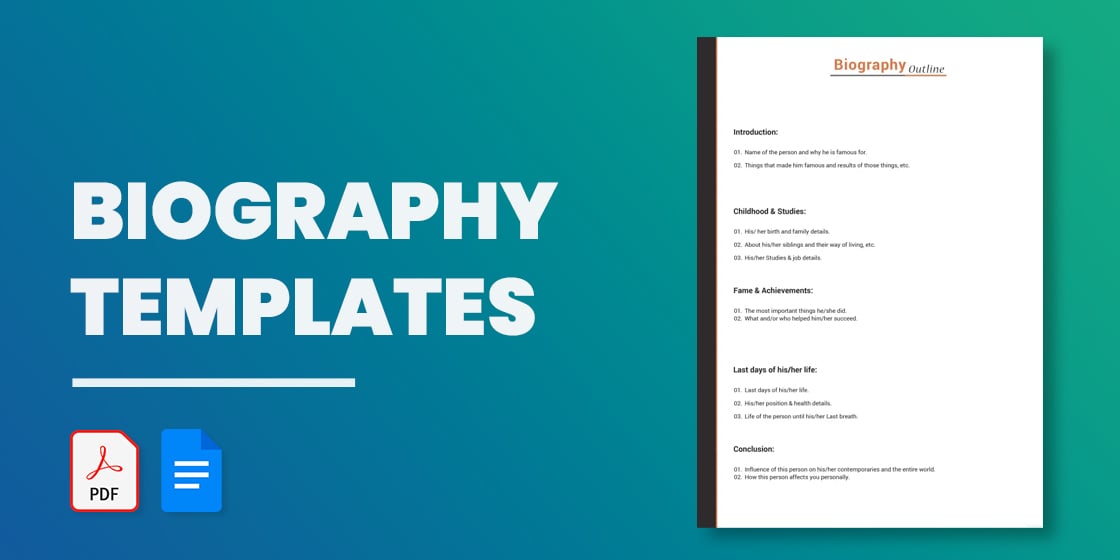
Free Biography Template
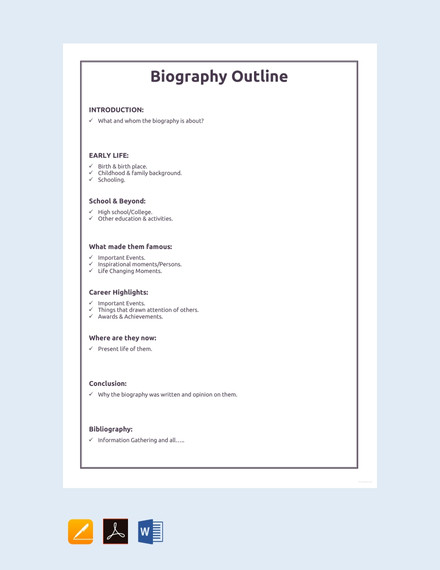
- Google Docs
- Apple Pages
Artist Bio Template Word
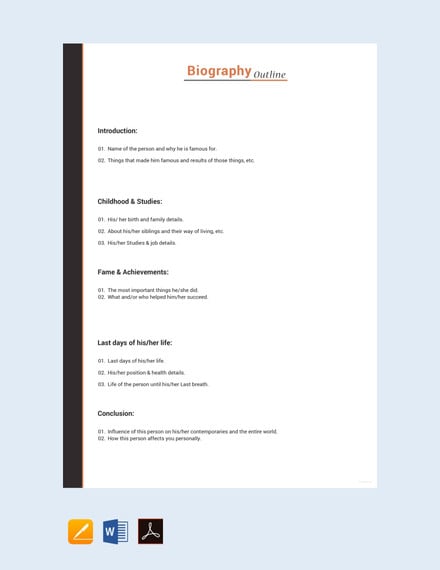
Biography Layout Template
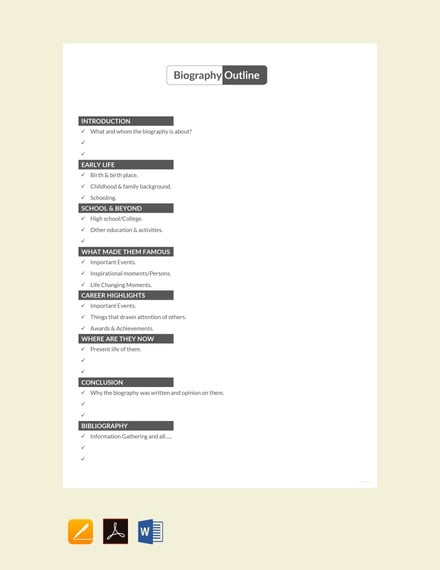
Personal Biography Template

Microsoft Word Bio Template
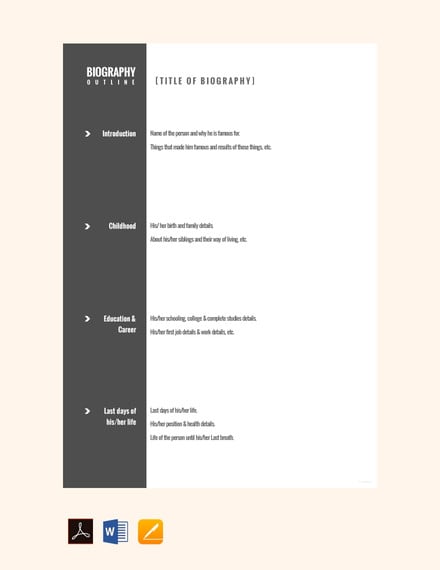
Sample Biography Template

Short Biography Template Word
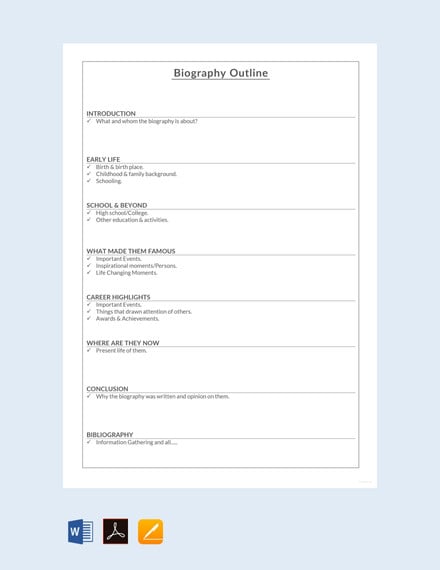
Bio Sheet Template

- Editable PDF
Biography Format Template
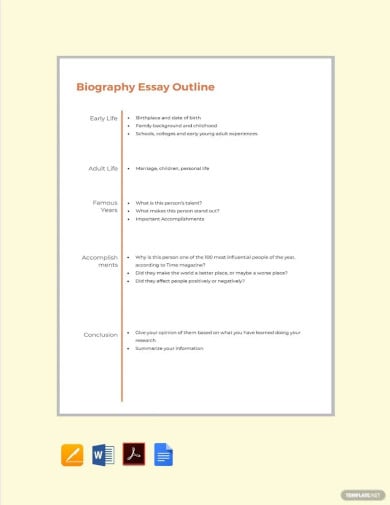
Simple Biography Template
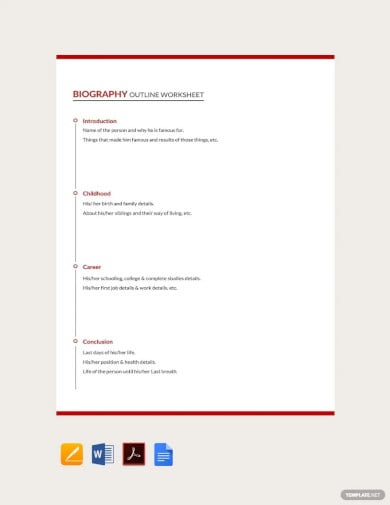
Biography Report Outline Template
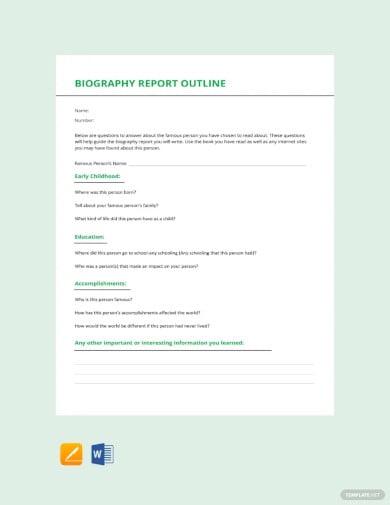
Photo Autobiography Book Cover Template
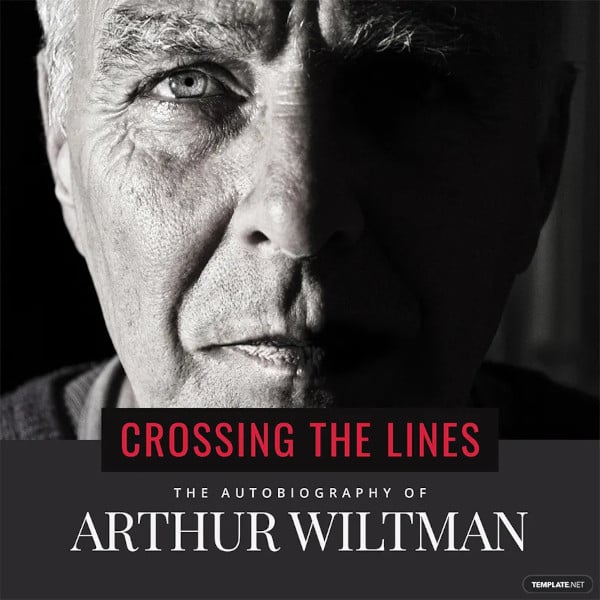
- PDF Photoshop
- Illustrator
- MS Publisher
Editable Biography Template

Bio Profile Template
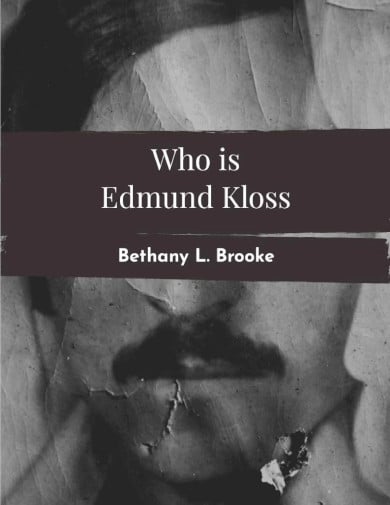
- Google Slides
- Apple Keynote
Biography Sample For Students PDF
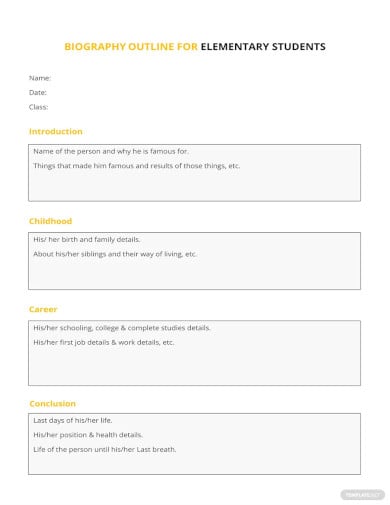
Biography Book Template
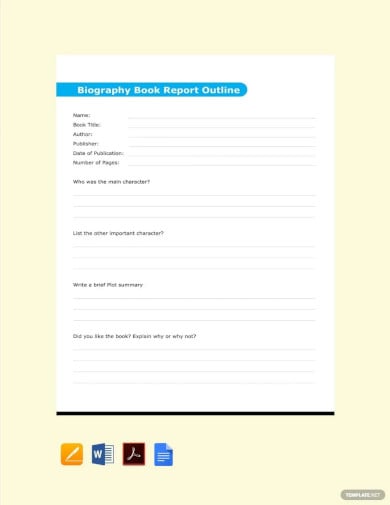
Sample Of Biography
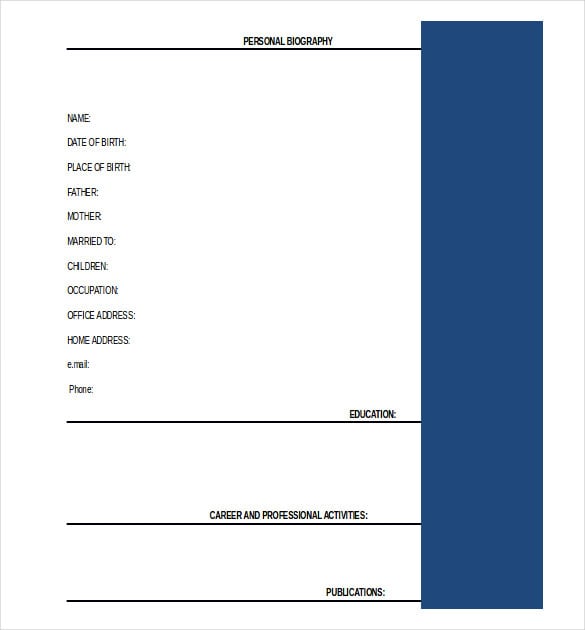
Biography Report Template
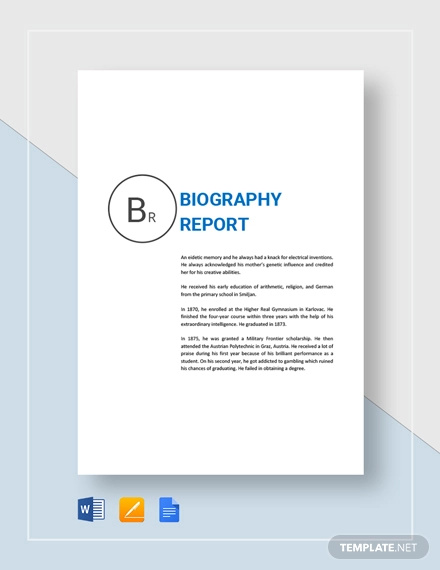
Professional Biography Template
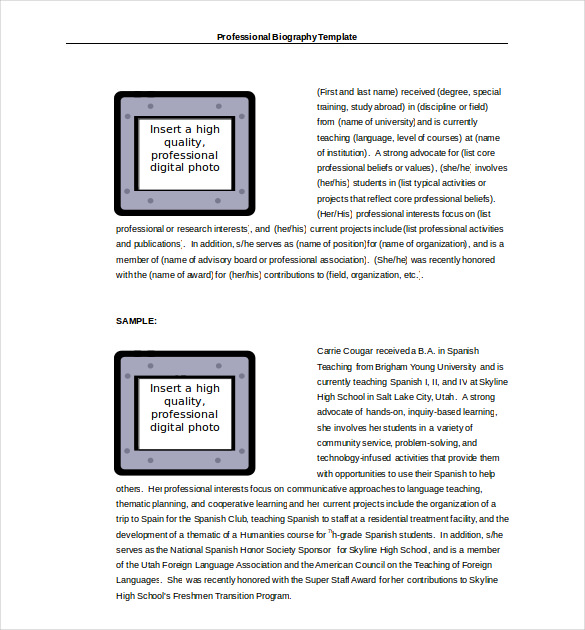
Biographical Narrative Essay Template
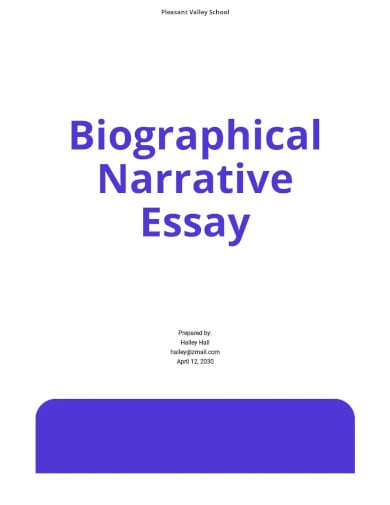
Biography Information Template
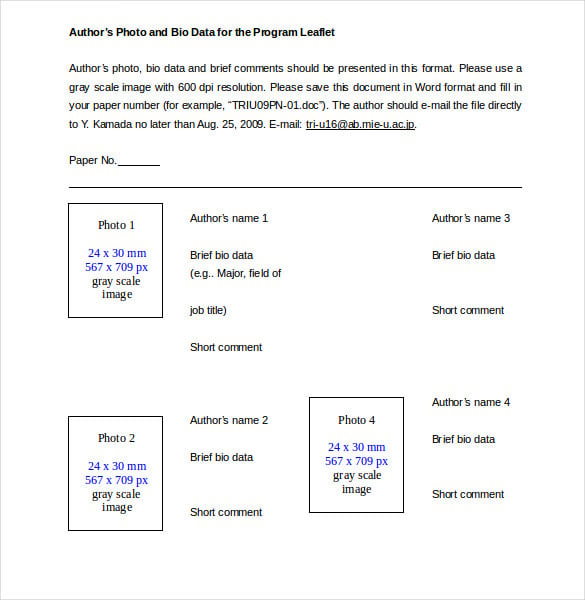
IEEE Biography Template Word File Download

Template for MCRD Army Officer High School Biography
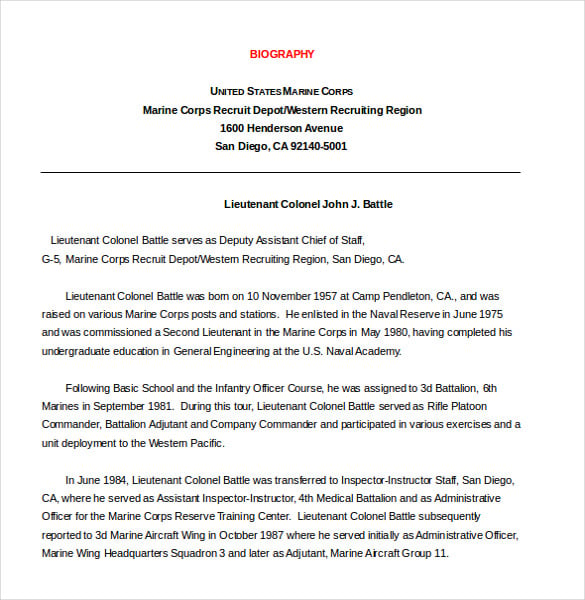
Student Autobiography Template Word Format
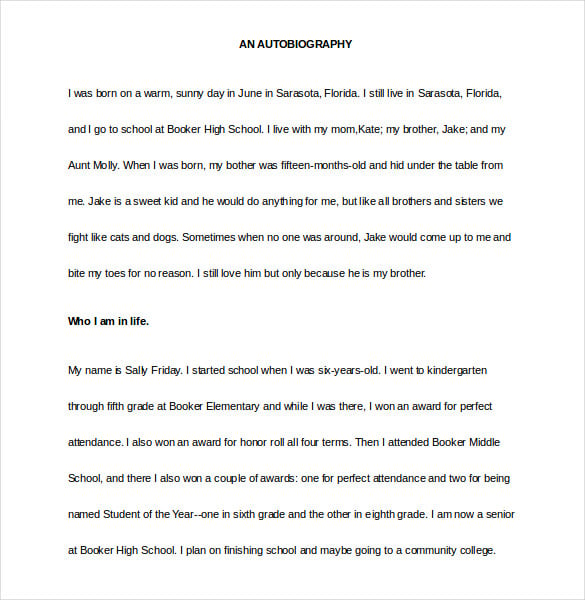
Writing a Biography PDF
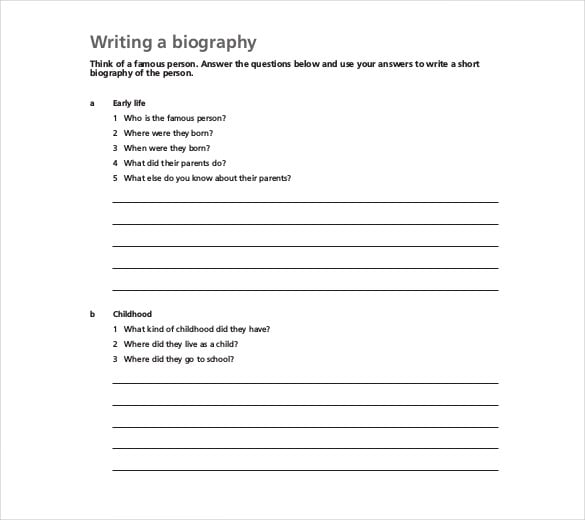
Air Force Biography Template PDF
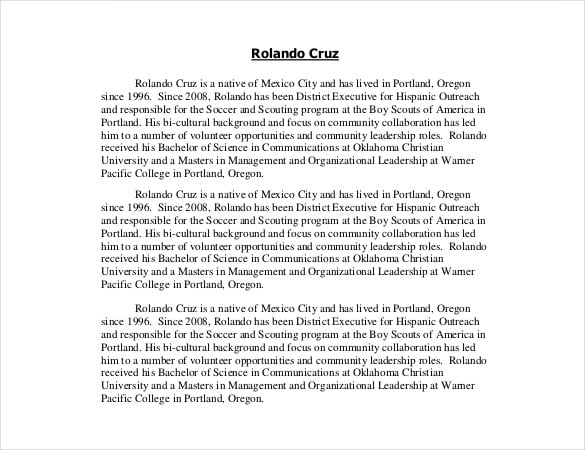
Biography Newspaper Article Template

Ministry Biography Timeline Template
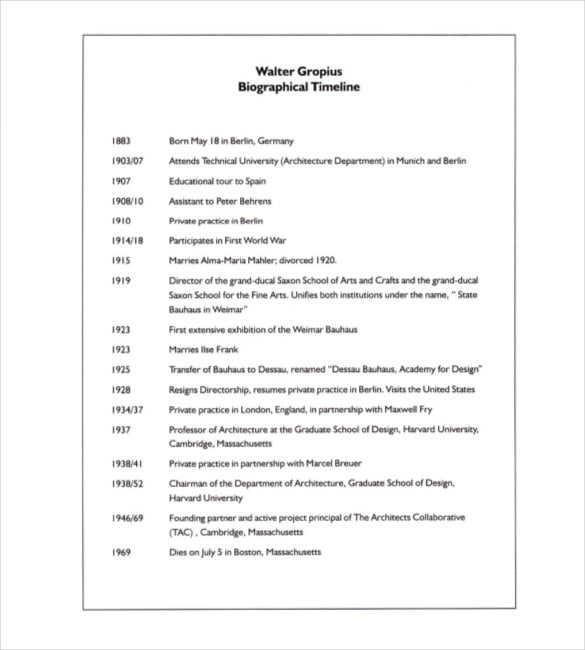
Blank Biography Teacher Template
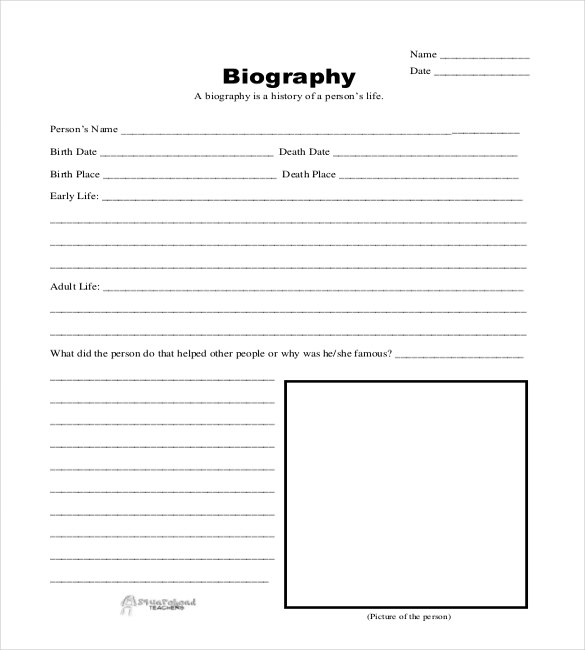

Life Story Biography Template
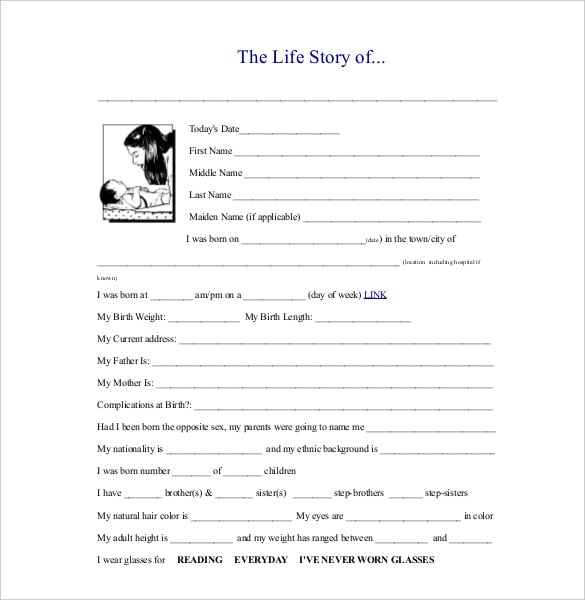
Biography Book Report Outline Template
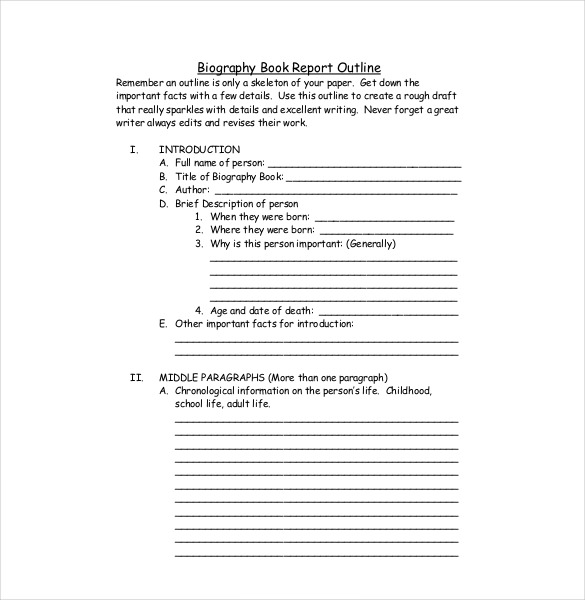
Military Command Biography Template PDF Download
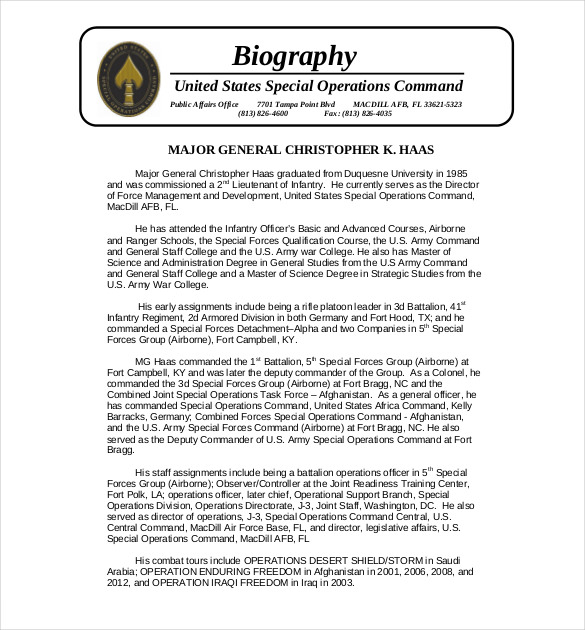
Executive Member Biography Sheet Template
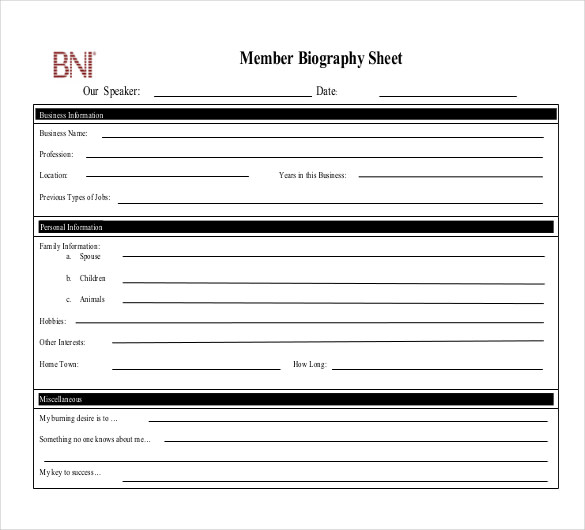
Aesthetic Biography Worksheet Elementary

Free Conference Biography Sketch Template
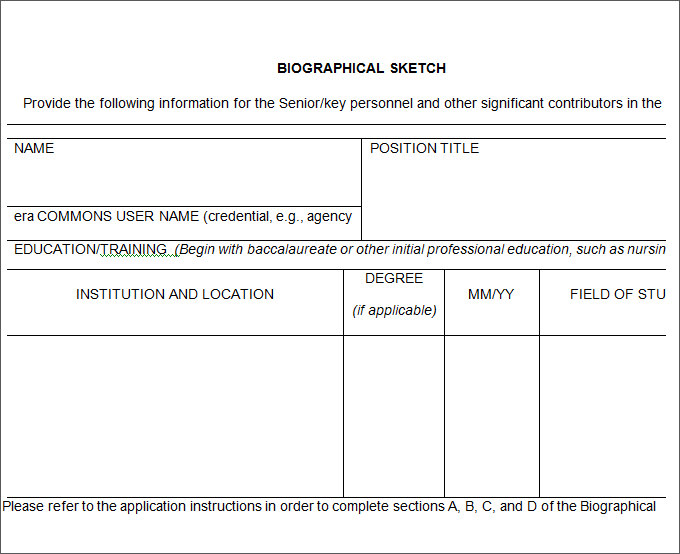
Biography Sample Free Word Template
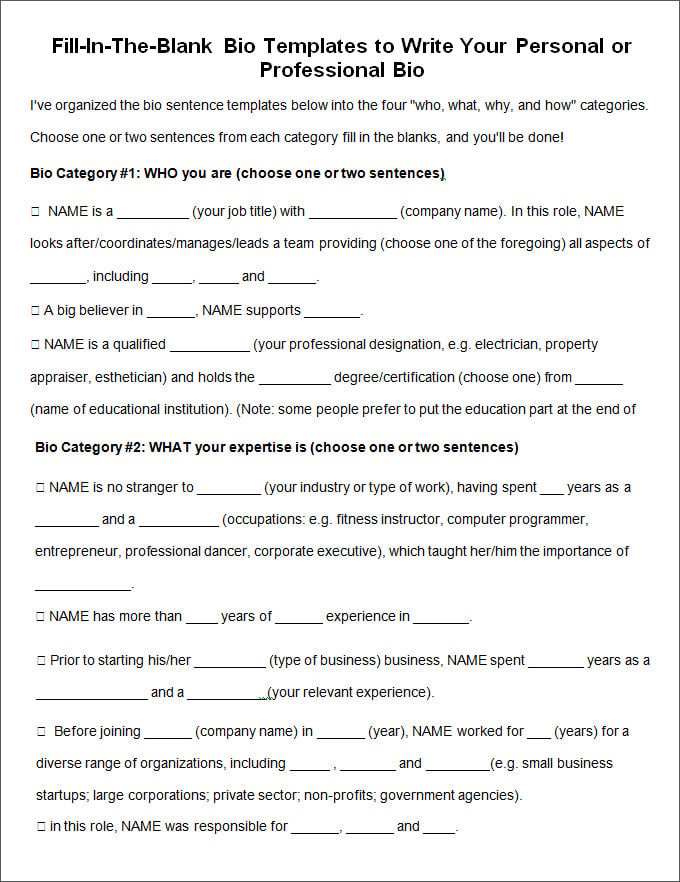
Biography Report Form
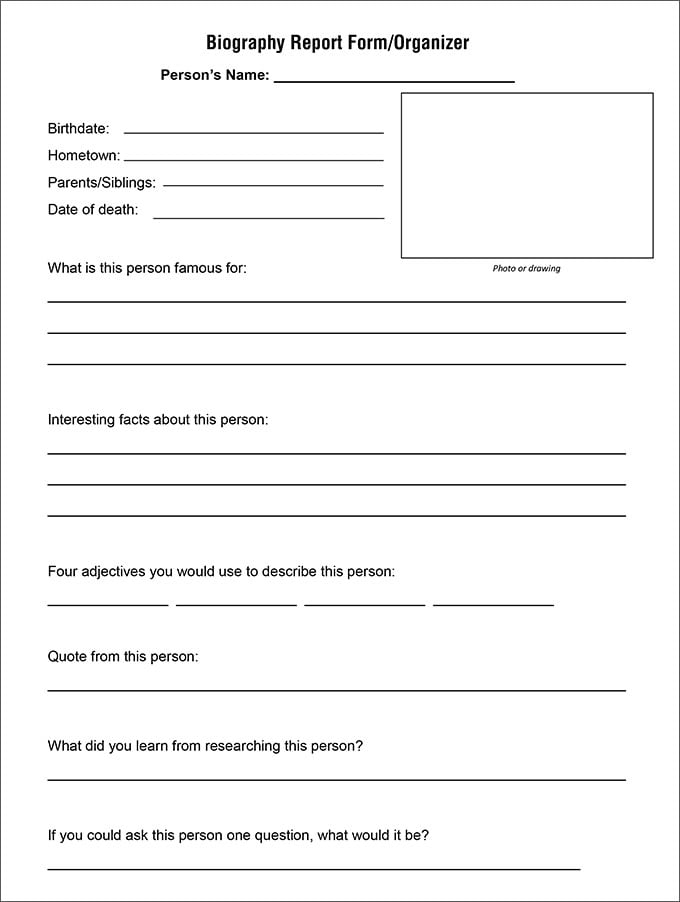
Navy Biography Template
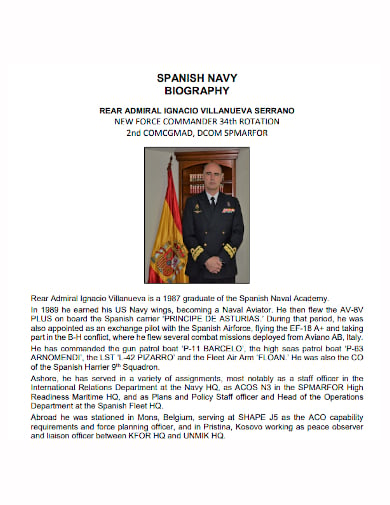
Child’s Kindergarten Project Biography Template
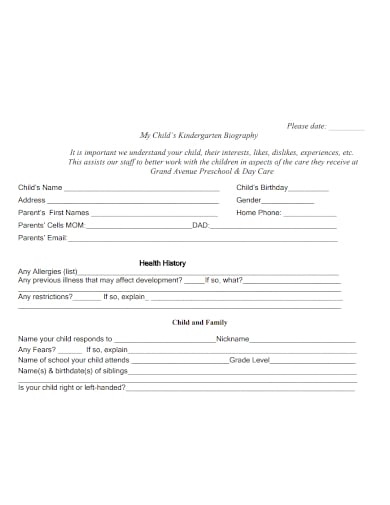
Why You Must Download and Use These Templates?
More in word templates, self bio template, personal biography outline template, biography example for kids, student biography template, short bio template, professional biography outline template, high school senior biography template, middle school biography example template, sample biography outline template.
- 28+ Blank Check Template – DOC, PSD, PDF & Vector Formats
- 39+ Funeral Program Templates in PDF | MS Word | Pages | Google Docs | AI | InDesign | Publishertest
- 55+ Download Flyer Templates – Word, PSD, Publisher
- 44+ Blank Bookmark Templates
- 51+ Meeting Agenda Templates – PDF, DOC
- 12+ Landscaping Estimate Templates – DOC, PDF, Excel
- 50+ Incident Report Templates – PDF, Docs, Apple Pages
- 23+ Word Procedure Templates
- 35+ Fact Sheet Templates – PDF, DOC, Apple Pages, Google Docs
- 40+ Blank Voucher Templates – Illustrator | InDesign | MS Word | Pages | Photoshop | Publisher | PDF
- Annual Report Template – 57+ Free Word, Excel, PDF, PPT, PSD
- 27+ T-Shirt Order Form Templates – PDF, DOC
- 29+ Outline Templates – PDF, DOC
- 32+ Blank Family Tree Templates
- 15+ MS Word Table of Contents
File Formats
Google docs templates, excel templates, powerpoint templates, google sheets templates, google slides templates, pdf templates, publisher templates, psd templates, indesign templates, illustrator templates, pages templates, keynote templates, numbers templates, outlook templates.

How to Write a Biography
Biographies are big business. Whether in book form or Hollywood biopics, the lives of the famous and sometimes not-so-famous fascinate us.
While it’s true that most biographies are about people who are in the public eye, sometimes the subject is less well-known. Primarily, though, famous or not, the person who is written about has led an incredible life.
In this article, we will explain biography writing in detail for teachers and students so they can create their own.
While your students will most likely have a basic understanding of a biography, it’s worth taking a little time before they put pen to paper to tease out a crystal-clear definition of one.

What Is a Biography?

A biography is an account of someone’s life written by someone else . While there is a genre known as a fictional biography, for the most part, biographies are, by definition, nonfiction.
Generally speaking, biographies provide an account of the subject’s life from the earliest days of childhood to the present day or, if the subject is deceased, their death.
The job of a biography is more than just to outline the bare facts of a person’s life.
Rather than just listing the basic details of their upbringing, hobbies, education, work, relationships, and death, a well-written biography should also paint a picture of the subject’s personality and experience of life.

Full Biographies
Teaching unit.
Teach your students everything they need to know about writing an AUTOBIOGRAPHY and a BIOGRAPHY.
⭐⭐⭐⭐⭐ ( 26 reviews )
Features of a Biography
Before students begin writing a biography, they’ll need to have a firm grasp of the main features of a Biography. An excellent way to determine how well they understand these essential elements is to ask them to compile a checklist like the one-blow
Their checklists should contain the items below at a minimum. Be sure to help them fill in any gaps before moving on to the writing process.
The purpose of a biography is to provide an account of someone’s life.
Biography structure.
ORIENTATION (BEGINNING) Open your biography with a strong hook to grab the reader’s attention
SEQUENCING: In most cases, biographies are written in chronological order unless you are a very competent writer consciously trying to break from this trend.
COVER: childhood, upbringing, education, influences, accomplishments, relationships, etc. – everything that helps the reader to understand the person.
CONCLUSION: Wrap your biography up with some details about what the subject is doing now if they are still alive. If they have passed away, make mention of what impact they have made and what their legacy is or will be.
BIOGRAPHY FEATURES
LANGUAGE Use descriptive and figurative language that will paint images inside your audience’s minds as they read. Use time connectives to link events.
PERSPECTIVE Biographies are written from the third person’s perspective.
DETAILS: Give specific details about people, places, events, times, dates, etc. Reflect on how events shaped the subject. You might want to include some relevant photographs with captions. A timeline may also be of use depending upon your subject and what you are trying to convey to your audience.
TENSE Written in the past tense (though ending may shift to the present/future tense)
THE PROCESS OF WRITING A BIOGRAPHY
Like any form of writing, you will find it simple if you have a plan and follow it through. These steps will ensure you cover the essential bases of writing a biography essay.
Firstly, select a subject that inspires you. Someone whose life story resonates with you and whose contribution to society intrigues you. The next step is to conduct thorough research. Engage in extensive reading, explore various sources, watch documentaries, and glean all available information to provide a comprehensive account of the person’s life.
Creating an outline is essential to organize your thoughts and information. The outline should include the person’s early life, education, career, achievements, and any other significant events or contributions. It serves as a map for the writing process, ensuring that all vital information is included.
Your biography should have an engaging introduction that captivates the reader’s attention and provides background information on the person you’re writing about. It should include a thesis statement summarising the biography’s main points.
Writing a biography in chronological order is crucial . You should begin with the person’s early life and move through their career and achievements. This approach clarifies how the person’s life unfolded and how they accomplished their goals.
A biography should be written in a narrative style , capturing the essence of the person’s life through vivid descriptions, anecdotes, and quotes. Avoid dry, factual writing and focus on creating a compelling narrative that engages the reader.
Adding personal insights and opinions can enhance the biography’s overall impact, providing a unique perspective on the person’s achievements, legacy, and impact on society.
Editing and proofreading are vital elements of the writing process. Thoroughly reviewing your biography ensures that the writing is clear, concise, and error-free. You can even request feedback from someone else to ensure that it is engaging and well-written.
Finally, including a bibliography at the end of your biography is essential. It gives credit to the sources that were used during research, such as books, articles, interviews, and websites.
Tips for Writing a Brilliant Biography
Biography writing tip #1: choose your subject wisely.
There are several points for students to reflect on when deciding on a subject for their biography. Let’s take a look at the most essential points to consider when deciding on the subject for a biography:
Interest: To produce a biography will require sustained writing from the student. That’s why students must choose their subject well. After all, a biography is an account of someone’s entire life to date. Students must ensure they choose a subject that will sustain their interest throughout the research, writing, and editing processes.
Merit: Closely related to the previous point, students must consider whether the subject merits the reader’s interest. Aside from pure labors of love, writing should be undertaken with the reader in mind. While producing a biography demands sustained writing from the author, it also demands sustained reading from the reader.
Therefore, students should ask themselves if their chosen subject has had a life worthy of the reader’s interest and the time they’d need to invest in reading their biography.
Information: Is there enough information available on the subject to fuel the writing of an entire biography? While it might be a tempting idea to write about a great-great-grandfather’s experience in the war. There would be enough interest there to sustain the author’s and the reader’s interest, but do you have enough access to information about their early childhood to do the subject justice in the form of a biography?
Biography Writing Tip #2: R esearch ! Research! Research!
While the chances are good that the student already knows quite a bit about the subject they’ve chosen. Chances are 100% that they’ll still need to undertake considerable research to write their biography.
As with many types of writing , research is an essential part of the planning process that shouldn’t be overlooked. If students wish to give as complete an account of their subject’s life as possible, they’ll need to put in the time at the research stage.
An effective way to approach the research process is to:
1. Compile a chronological timeline of the central facts, dates, and events of the subject’s life
2. Compile detailed descriptions of the following personal traits:
- Physical looks
- Character traits
- Values and beliefs
3. Compile some research questions based on different topics to provide a focus for the research:
- Childhood : Where and when were they born? Who were their parents? Who were the other family members? What education did they receive?
- Obstacles: What challenges did they have to overcome? How did these challenges shape them as individuals?
- Legacy: What impact did this person have on the world and/or the people around them?
- Dialogue & Quotes: Dialogue and quotations by and about the subject are a great way to bring color and life to a biography. Students should keep an eagle eye out for the gems that hide amid their sources.
As the student gets deeper into their research, new questions will arise that can further fuel the research process and help to shape the direction the biography will ultimately go in.
Likewise, during the research, themes will often begin to suggest themselves. Exploring these themes is essential to bring depth to biography, but we’ll discuss this later in this article.
Research Skills:
Researching for biography writing is an excellent way for students to hone their research skills in general. Developing good research skills is essential for future academic success. Students will have opportunities to learn how to:
- Gather relevant information
- Evaluate different information sources
- Select suitable information
- Organize information into a text.
Students will have access to print and online information sources, and, in some cases, they may also have access to people who knew or know the subject (e.g. biography of a family member).
These days, much of the research will likely take place online. It’s crucial, therefore, to provide your students with guidance on how to use the internet safely and evaluate online sources for reliability. This is the era of ‘ fake news ’ and misinformation after all!
COMPLETE TEACHING UNIT ON INTERNET RESEARCH SKILLS USING GOOGLE SEARCH

Teach your students ESSENTIAL SKILLS OF THE INFORMATION ERA to become expert DIGITAL RESEARCHERS.
⭐How to correctly ask questions to search engines on all devices.
⭐ How to filter and refine your results to find exactly what you want every time.
⭐ Essential Research and critical thinking skills for students.
⭐ Plagiarism, Citing and acknowledging other people’s work.
⭐ How to query, synthesize and record your findings logically.
BIOGRAPHY WRITING Tip #3: Find Your Themes In Biography Writing
Though predominantly a nonfiction genre, the story still plays a significant role in good biography writing. The skills of characterization and plot structuring are transferable here. And, just like in fiction, exploring themes in a biographical work helps connect the personal to the universal. Of course, these shouldn’t be forced; this will make the work seem contrived, and the reader may lose faith in the truthfulness of the account. A biographer needs to gain and maintain the trust of the reader.
Fortunately, themes shouldn’t need to be forced. A life well-lived is full of meaning, and the themes the student writer is looking for will emerge effortlessly from the actions and events of the subject’s life. It’s just a case of learning how to spot them.
One way to identify the themes in a life is to look for recurring events or situations in a person’s life. These should be apparent from the research completed previously. The students should seek to identify these patterns that emerge in the subject’s life. For example, perhaps they’ve had to overcome various obstacles throughout different periods of their life. In that case, the theme of overcoming adversity is present and has been identified.
Usually, a biography has several themes running throughout, so be sure your students work to identify more than one theme in their subject’s life.
BIOGRAPHY WRITING Tip: #4 Put Something of Yourself into the Writing
While the defining feature of a biography is that it gives an account of a person’s life, students must understand that this is not all a biography does. Relating the facts and details of a subject’s life is not enough. The student biographer should not be afraid to share their thoughts and feelings with the reader throughout their account of their subject’s life.
The student can weave some of their personality into the fabric of the text by providing commentary and opinion as they relate the events of the person’s life and the wider social context at the time. Unlike the detached and objective approach we’d expect to find in a history textbook, in a biography, student-writers should communicate their enthusiasm for their subject in their writing.
This makes for a more intimate experience for the reader, as they get a sense of getting to know the author and the subject they are writing about.
Biography Examples For Students
- Year 5 Example
- Year 7 Example
- Year 9 Example
“The Rock ‘n’ Roll King: Elvis Presley”
Elvis Aaron Presley, born on January 8, 1935, was an amazing singer and actor known as the “King of Rock ‘n’ Roll.” Even though he’s been dead for nearly 50 years, I can’t help but be fascinated by his incredible life!
Elvis grew up in Tupelo, Mississippi, in a tiny house with his parents and twin brother. His family didn’t have much money, but they shared a love for music. Little did they know Elvis would become a music legend!
When he was only 11 years old, Elvis got his first guitar. He taught himself to play and loved singing gospel songs. As he got older, he started combining different music styles like country, blues, and gospel to create a whole new sound – that’s Rock ‘n’ Roll!
In 1954, at the age of 19, Elvis recorded his first song, “That’s All Right.” People couldn’t believe how unique and exciting his music was. His famous hip-swinging dance moves also made him a sensation!
Elvis didn’t just rock the music scene; he also starred in movies like “Love Me Tender” and “Jailhouse Rock.” But fame came with challenges. Despite facing ups and downs, Elvis kept spreading happiness through his music.

Tragically, Elvis passed away in 1977, but his music and charisma live on. Even today, people worldwide still enjoy his songs like “Hound Dog” and “Can’t Help Falling in Love.” Elvis Presley’s legacy as the King of Rock ‘n’ Roll will live forever.
Long Live the King: I wish I’d seen him.
Elvis Presley, the Rock ‘n’ Roll legend born on January 8, 1935, is a captivating figure that even a modern-day teen like me can’t help but admire. As I delve into his life, I wish I could have experienced the magic of his live performances.
Growing up in Tupelo, Mississippi, Elvis faced challenges but found solace in music. At 11, he got his first guitar, a symbol of his journey into the world of sound. His fusion of gospel, country, and blues into Rock ‘n’ Roll became a cultural phenomenon.
The thought of being in the audience during his early performances, especially when he recorded “That’s All Right” at 19, sends shivers down my spine. Imagining the crowd’s uproar and feeling the revolutionary energy of that moment is a dream I wish I could have lived.
Elvis wasn’t just a musical prodigy; he was a dynamic performer. His dance moves, the embodiment of rebellion, and his roles in films like “Love Me Tender” and “Jailhouse Rock” made him a true icon.
After watching him on YouTube, I can’t help but feel a little sad that I’ll never witness the King’s live performances. The idea of swaying to “Hound Dog” or being enchanted by “Can’t Help Falling in Love” in person is a missed opportunity. Elvis may have left us in 1977, but he was the king of rock n’ roll. Long live the King!
Elvis Presley: A Teen’s Take on the Rock ‘n’ Roll Icon”
Elvis Presley, born January 8, 1935, was a revolutionary force in the music world, earning his title as the “King of Rock ‘n’ Roll.” Exploring his life, even as a 16-year-old today, I’m captivated by the impact he made.
Hailing from Tupelo, Mississippi, Elvis grew up in humble beginnings, surrounded by the love of his parents and twin brother. It’s inspiring to think that, despite financial challenges, this young man would redefine the music scene.
At 11, Elvis got his first guitar, sparking a self-taught journey into music. His early gospel influences evolved into a unique fusion of country, blues, and gospel, creating the electrifying genre of Rock ‘n’ Roll. In 1954, at only 19, he recorded “That’s All Right,” marking the birth of a musical legend.
Elvis wasn’t just a musical innovator; he was a cultural phenomenon. His rebellious dance moves and magnetic stage presence challenged the norms. He transitioned seamlessly into acting, starring in iconic films like “Love Me Tender” and “Jailhouse Rock.”

However, fame came at a cost, and Elvis faced personal struggles. Despite the challenges, his music continued to resonate. Even now, classics like “Hound Dog” and “Can’t Help Falling in Love” transcend generations.
Elvis Presley’s impact on music and culture is undeniable. He was known for his unique voice, charismatic persona, and electrifying performances. He sold over one billion records worldwide, making him one of the best-selling solo artists in history. He received numerous awards throughout his career, including three Grammy Awards and the Grammy Lifetime Achievement Award.
Elvis’s influence can still be seen in today’s music. Many contemporary artists, such as Bruno Mars, Lady Gaga, and Justin Timberlake, have cited Elvis as an inspiration. His music continues to be featured in movies, TV shows, and commercials.
Elvis left us in 1977, but his legacy lives on. I appreciate his breaking barriers and fearlessly embracing his artistic vision. Elvis Presley’s impact on music and culture is timeless, a testament to the enduring power of his artistry. His music has inspired generations and will continue to do so for many years to come.

Teaching Resources
Use our resources and tools to improve your student’s writing skills through proven teaching strategies.
BIOGRAPHY WRITING TEACHING IDEAS AND LESSONS
We have compiled a sequence of biography-related lessons or teaching ideas that you can follow as you please. They are straightforward enough for most students to follow without further instruction.
BIOGRAPHY LESSON IDEA # 1:
This session aims to give students a broader understanding of what makes a good biography.
Once your students have compiled a comprehensive checklist of the main features of a biography, allow them to use it to assess some biographies from your school library or on the internet using the feature checklist.
When students have assessed a selection of biographies, take some time as a class to discuss them. You can base the discussion around the following prompts:
- Which biographies covered all the criteria from their checklist?
- Which biographies didn’t?
- Which biography was the most readable in terms of structure?
- Which biography do you think was the least well-structured? How would you improve this?
Looking at how other writers have interpreted the form will help students internalize the necessary criteria before attempting to produce a biography. Once students have a clear understanding of the main features of the biography, they’re ready to begin work on writing a biography.
When the time does come to put pen to paper, be sure they’re armed with the following top tips to help ensure they’re as well prepared as possible.
BIOGRAPHY LESSON IDEA # 2:
This session aims to guide students through the process of selecting the perfect biography subject.
Instruct students to draw up a shortlist of three potential subjects for the biography they’ll write.
Using the three criteria mentioned in the writing guide (Interest, Merit, and Information), students award each potential subject a mark out of 5 for each of the criteria. In this manner, students can select the most suitable subject for their biography.
BIOGRAPHY LESSON IDEA # 3:
This session aims to get students into the researching phase, then prioritise and organise events chronologically.
Students begin by making a timeline of their subject’s life, starting with their birth and ending with their death or the present day. If the student has yet to make a final decision on the subject of their biography, a family member will often serve well for this exercise as a practice exercise.
Students should research and gather the key events of the person’s life, covering each period of their life from when they were a baby, through childhood and adolescence, right up to adulthood and old age. They should then organize these onto a timeline. Students can include photographs with captions if they have them.
They can present these to the class when they have finished their timelines.
BIOGRAPHY LESSON IDEA # 4:
Instruct students to look over their timeline, notes, and other research. Challenge them to identify three patterns that repeat throughout the subject’s life and sort all the related events and incidents into specific categories.
Students should then label each category with a single word. This is the thematic concept or the broad general underlying idea. After that, students should write a sentence or two expressing what the subject’s life ‘says’ about that concept.
This is known as the thematic statement . With the thematic concepts and thematic statements identified, the student now has some substantial ideas to explore that will help bring more profound meaning and wider resonance to their biography.
BIOGRAPHY LESSON IDEA # 5:
Instruct students to write a short objective account of an event in their own life. They can write about anyone from their past. It needn’t be more than a couple of paragraphs, but the writing should be strictly factual, focusing only on the objective details of what happened.
Once they have completed this, it’s time to rewrite the paragraph, but they should include some opinion and personal commentary this time.
The student here aims to inject some color and personality into their writing, to transform a detached, factual account into a warm, engaging story.
A COMPLETE UNIT ON TEACHING BIOGRAPHIES

Teach your students to write AMAZING BIOGRAPHIES & AUTOBIOGRAPHIES using proven RESEARCH SKILLS and WRITING STRATEGIES .
- Understand the purpose of both forms of biography.
- Explore the language and perspective of both.
- Prompts and Challenges to engage students in writing a biography.
- Dedicated lessons for both forms of biography.
- Biographical Projects can expand students’ understanding of reading and writing a biography.
- A COMPLETE 82-PAGE UNIT – NO PREPARATION REQUIRED.

FREE Biography Writing Graphic Organizer
Use this valuable tool in the research and writing phases to keep your students on track and engaged.
WRITING CHECKLIST & RUBRIC BUNDLE

⭐⭐⭐⭐⭐ (92 Reviews)
To Conclude
By this stage, your students should have an excellent technical overview of a biography’s essential elements.
They should be able to choose their subject in light of how interesting and worthy they are, as well as give consideration to the availability of information out there. They should be able to research effectively and identify emerging themes in their research notes. And finally, they should be able to bring some of their personality and uniqueness into their retelling of the life of another.
Remember that writing a biography is not only a great way to develop a student’s writing skills; it can be used in almost all curriculum areas. For example, to find out more about a historical figure in History, to investigate scientific contributions to Science, or to celebrate a hero from everyday life.
Biography is an excellent genre for students to develop their writing skills and to find inspiration in the lives of others in the world around them.
HOW TO WRITE A BIOGRAPHY TUTORIAL VIDEO

OTHER GREAT ARTICLES RELATED TO BIOGRAPHY WRITING

How to write an Autobiography

How to Write a Historical Recount Text

15 Awesome Recount & Personal Narrative Topics

Personal Narrative Writing Guide

Free Editable Biography Templates
Design a free creative biography template. engage your students to discover the power of synthesis and learn about the lives of famous authors..
Customize Biography templates online . Use Edit.org to customize your biographies for schools, bookstores, and libraries. Create biographies about characters from a novel quickly and in a structured way.
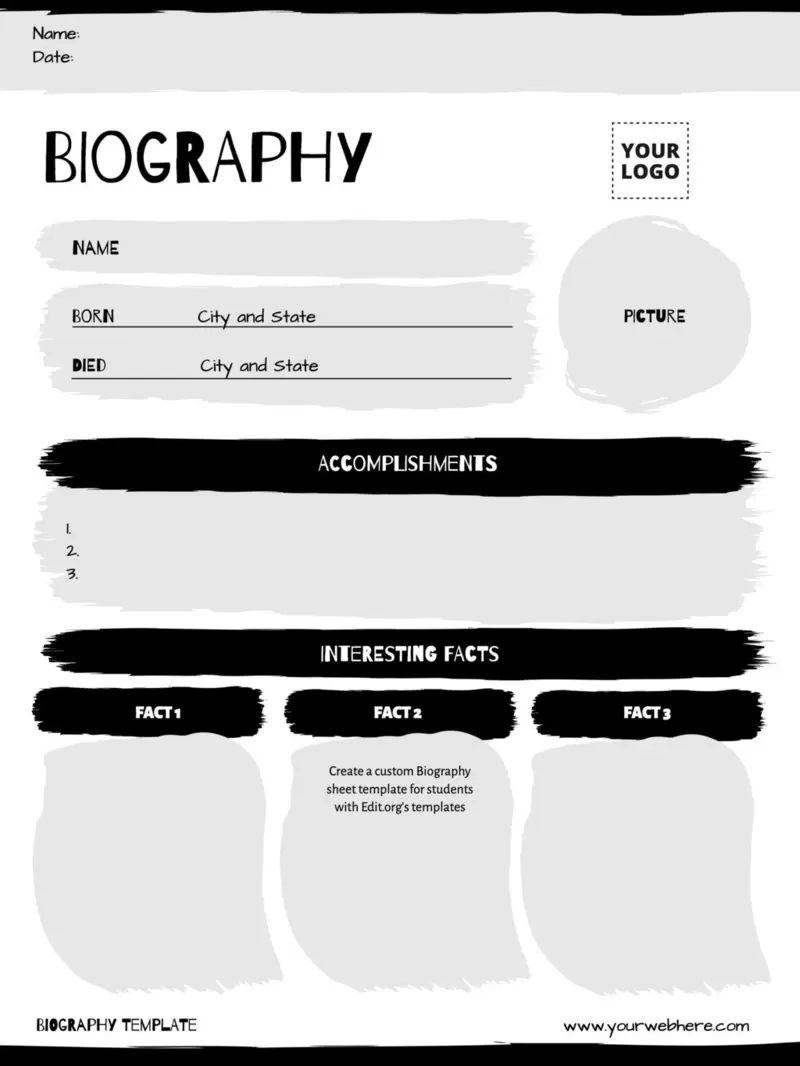
Customize professional Bio examples online
At Edit.org, we have created a collection of editable biography templates that can be used by students, writers, journalists, and anyone who needs to create a biography of famous people, whether they are scientists, athletes, politicians, or singers. They contain predefined sections and fields that you can fill in as easily as in a Word document, including:
- Date and place of birth
- Place of residence
- Friends and acquaintances
- Hobbies and interests
- People of reference
- And many more
Get spectacular designs for your biography! Use it in a school, magazine, or website . You can also use it in your bookstore, library, or cultural center .
Using our template library will save you time since you won't have to start from scratch as you will have a predefined structure. Create didactic activities in your classroom and organize biographical information in a clearer and more coherent way. Just select one of the templates we offer in this article or the final cascade, customize it with your educational proposals, and print it in high resolution.
Our biographies can be adapted to your needs . You can also use them as a page for a memory book or a resume .

How to edit free personal Bio examples on Edit.org?
See how easy it is to edit short or long professional biography examples:
- Click on a design you like from this article or choose the template that best suits your activity from the editor's search engine.
- Customize the template with just a few clicks. Edit it to your liking, including colors, typography, and more.
- Save your work in our free cloud in case you want to make changes later (so you won't have to start from scratch).
- Download your biography in JPG, PNG, or PDF format for high-quality printing or digital sharing.
That's it, you're done!
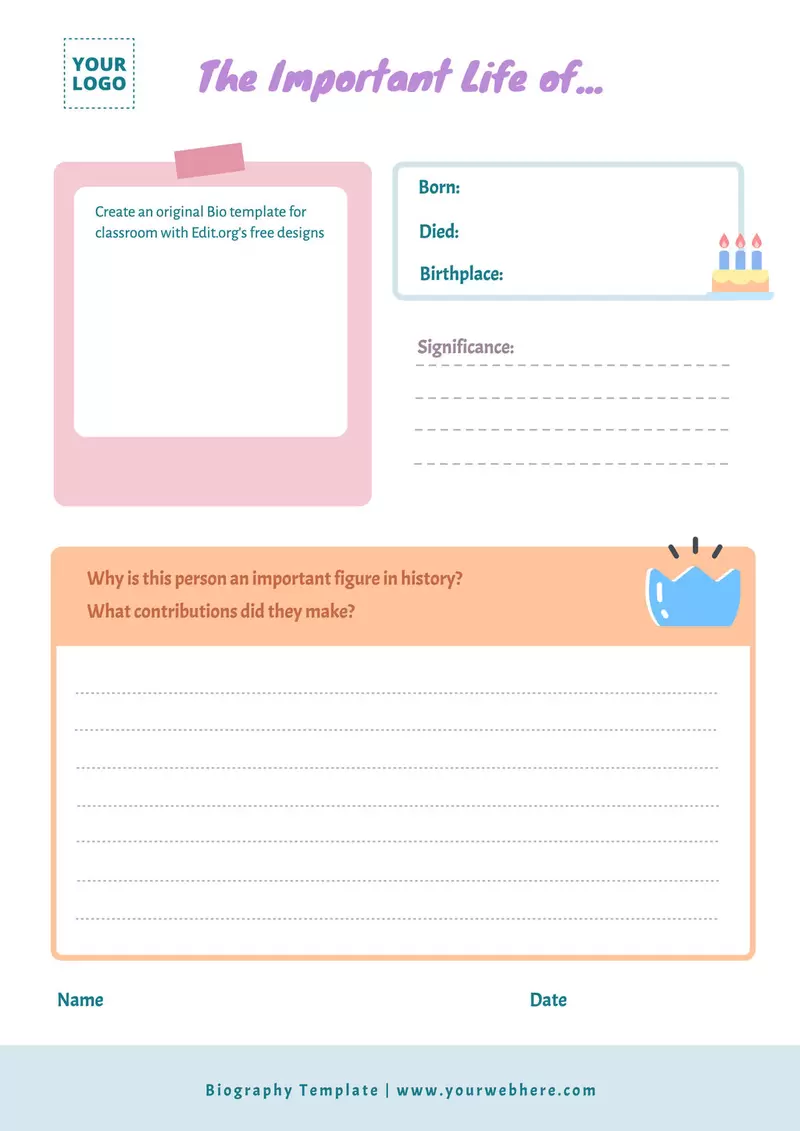
Why is it a good idea to make a Biography as a school activity?
There are many reasons, but here are the 4 main ones:
- Researching someone's life and gathering information about their accomplishments, personal and professional challenges, as well as their contributions, will help students develop research skills and curiosity .
- Working on a biography improves writing skills, organization of ideas, and structuring information in a clear and coherent manner.
- Promotes critical thinking : students will learn to analyze different aspects of a public figure's life and develop their objective thinking about that person, history, and society in general. It also promotes empathy.
- Learn about the lives of influential people in different fields , such as science, politics, or art, and understand how their contributions have affected the world at large.
In short, doing a biography as a school activity is a great idea! It encourages research and understanding towards different life experiences and perspectives.
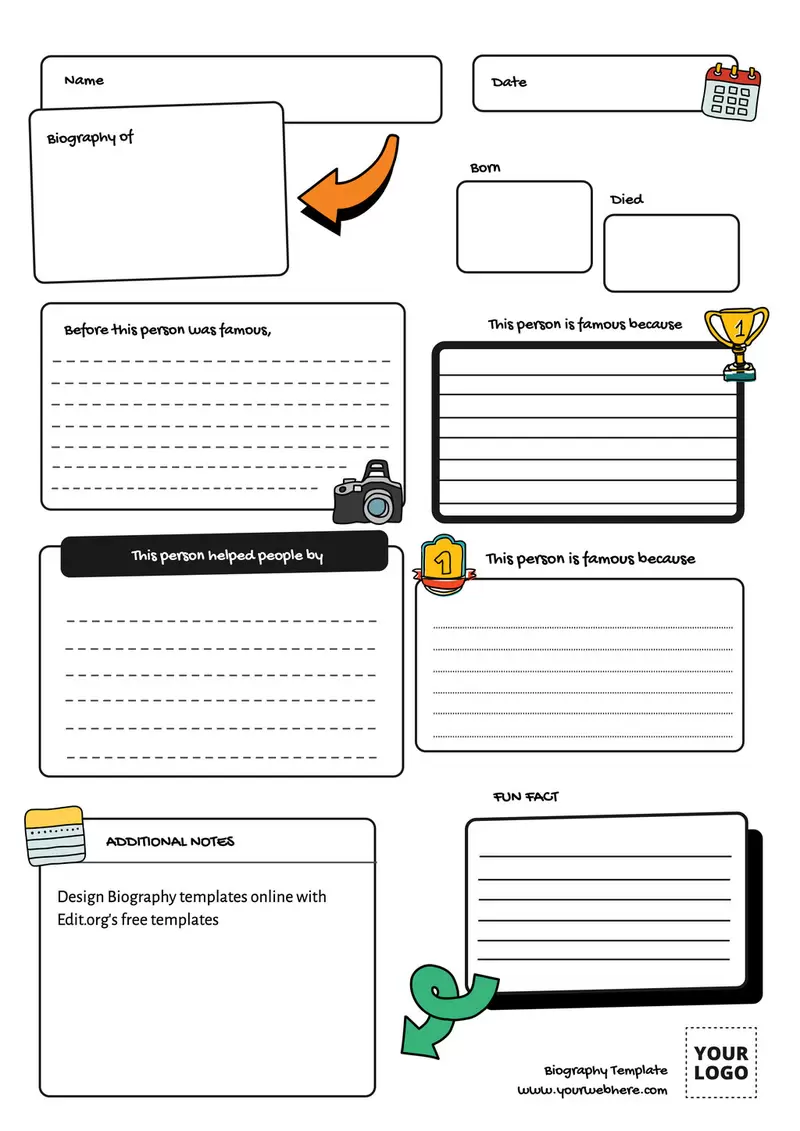
Download a Biography template for school students in minutes
Using Edit.org's online editor is easy! You don't need any design skills to create the best biographies for chronological, topical, or historical figures .
In just a few seconds, you can have your perfect template ready to share with your students or to help you write your bestseller and create new characters for your crime novel. Each template's visual result is designed to be professional, clear, and, above all, useful .
Create the best biographies with our free and intuitive editor in an easy, fast, and structured way. Use the best editable biography templates to gather information for your journalistic, literary, or research projects.
Enter our online editor now and download your personalized biography template in seconds!
Customizable Character Bio examples
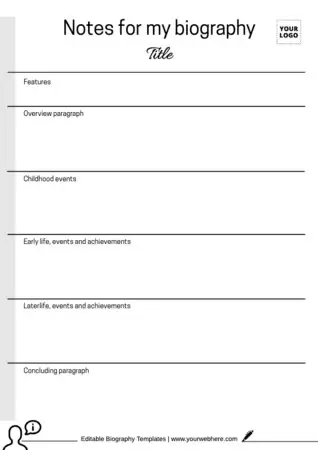
What Is Biography? Definition, Usage, and Literary Examples
Biography definition.
A biography (BYE-og-ruh-fee) is a written account of one person’s life authored by another person. A biography includes all pertinent details from the subject’s life, typically arranged in a chronological order. The word biography stems from the Latin biographia , which succinctly explains the word’s definition: bios = “life” + graphia = “write.”
Since the advent of the written word, historical writings have offered information about real people, but it wasn’t until the 18th century that biographies evolved into a separate literary genre. Autobiographies and memoirs fall under the broader biography genre, but they are distinct literary forms due to one key factor: the subjects themselves write these works. Biographies are popular source materials for documentaries, television shows, and motion pictures.
The History of Biographies
The biography form has its roots in Ancient Rome and Greece. In 44 BCE, Roman writer Cornelius Nepos published Excellentium Imperatorum Vitae ( Lives of the Generals ), one of the earliest recorded biographies. In 80 CE, Greek writer Plutarch released Parallel Lives , a sweeping work consisting of 48 biographies of famous men. In 121 CE, Roman historian Suetonius wrote De vita Caesarum ( On the Lives of the Caesars ), a series of 12 biographies detailing the lives of Julius Caesar and the first 11 emperors of the Roman Empire. These were among the most widely read biographies of their time, and at least portions of them have survived intact over the millennia.
During the Middle Ages, the Roman Catholic Church had a notable influence on biographies. Historical, political, and cultural biographies fell out of favor. Biographies of religious figures—including saints, popes, and church founders—replaced them. One notable exception was Italian painter/architect Giorgio Vasari’s 1550 biography, The Lives of the Most Excellent Painters, Sculptors, and Architects , which was immensely popular. In fact, it is one of the first examples of a bestselling book.
Still, it wasn’t until the 18th century that authors began to abandon multiple subjects in a single work and instead focus their research and writing on one subject. Scholars consider James Boswell’s 1791 The Life of Samuel Johnson to be the first modern biography. From here, biographies were established as a distinct literary genre, separate from more general historical writing.
As understanding of psychology and sociology grew in the 19th and early 20th centuries, biographies further evolved, offering up even more comprehensive pictures of their subjects. Authors who played major roles in this contemporary approach to biographing include Lytton Strachey, Gamaliel Bradford, and Robert Graves.
Types of Biographies
While all biographical works chronicle the lives of real people, writers can present the information in several different ways.
- Popular biographies are life histories written for a general readership. The Immortal Life of Henrietta Lacks by Rebecca Skloot and Into the Wild by Jon Krakauer are two popular examples.
- Critical biographies discuss the relationship between the subject’s life and the work they produced or were involved in; for example, The Billionaire Who Wasn’t: How Chuck Feeney Secretly Made and Gave Away a Fortune by Conor O’Clery and Unpresidented: A Biography of Donald Trump by Martha Brockenbrough.
- Historical biographies put greater understanding on how the subject’s life and contributions affected or were affected by the times in which they lived; see John Adams by David McCullough and Catherine the Great by Peter K. Massie.
- Literary biographies concentrate almost exclusively on writers and artists, blending a conventional narrative of the historical facts of the subject’s life with an exploration of how these facts impacted their creative output. Some examples include Savage Beauty: The Life of Edna St. Vincent Millay by Nancy Milford and Jackson Pollock: An American Saga by Gregory White Smith and Steven Naifeh.
- Reference biographies are more scholarly writings, usually written by multiple authors and covering multiple lives around a single topic. They verify facts, provide background details, and contribute supplemental information resources, like bibliographies, glossaries, and historical documents; for example, Black Americans in Congress, 1870-2007 and the Dictionary of Canadian Biography .
- Fictional biographies, or biographical novels, like The Other Boleyn Girl by Philippa Gregory, incorporate creative license into the retelling of a real person’s story by taking on the structure and freedoms of a novel. The term can also describe novels in which authors give an abundance of background information on their characters, to the extent that the novel reads more like a biography than fiction. An example of this is George R.R. Martin’s Fire and Blood , a novel detailing the history of a royal family from his popular A Song of Ice and Fire
Biographies and Filmed Entertainment
Movie makers and television creators frequently produce biographical stories, either as dramatized productions based on real people or as nonfiction accounts.
Documentary
This genre is a nonfictional movie or television show that uses historical records to tell the story of a subject. The subject might be a one person or a group of people, or it might be a certain topic or theme. To present a biography in a visually compelling way, documentaries utilize archival footage, recreations, and interviews with subjects, scholars, experts, and others associated with the subject.
Famous film documentaries include Grey Gardens, a biography of two of Jacqueline Kennedy’s once-wealthy cousins, who, at the time of filming, lived in squalor in a condemned mansion in the Hamptons; and I Am Not Your Negro , a biography of the life and legacy of pioneering American author James Baldwin.
Television documentary series tell one story over the course of several episodes, like The Jinx : The Life and Deaths of Robert Durst , a biography of the real estate heir and alleged serial killer that focused on his suspected crimes. There are many nonfiction television shows that use a documentary format, but subjects typically change from one episode to the next, such as A&E’s Biography and PBS’s POV .
These films are biographical motion pictures, written by screenwriters and performed by actors. They often employ a certain amount of creative liberty in their interpretation of a real life. This is largely done to maintain a feasible runtime; capturing all of the pivotal moments of a subject’s life in a 90- or 120-minute movie is all but impossible. So, filmmakers might choose to add, eliminate, or combine key events and characters, or they may focus primarily on one or only a few aspects of the subject’s life. Some popular examples: Coal Miner’s Daughter , a biography of country music legend Loretta Lynn; Malcom X , a biopic centered on the civil rights leader of the same name; and The King’s Speech , a dramatization of Prince Albert’s efforts to overcome a stutter and ascend the English throne.
Semi-fictionalized account
This approach takes a real-life event and interprets or expands it in ways that stray beyond what actually happened. This is done for entertainment and to build the story so it fits the filmmaker’s vision or evolves into a longer form, such as a multi-season television show. These accounts sometimes come with the disclaimer that they are “inspired by true events.” Examples of semi-fictionalized accounts are the TV series Orange Is the New Black , Masters of Sex , and Mozart of the Jungle —each of which stem from at least one biographical element, but showrunners expounded upon to provide many seasons of entertainment.
The Functions of Biography
Biographies inform readers about the life of a notable person. They are a way to introduce readers to the work’s subject—the historical details, the subject’s motivations and psychological underpinnings, and their environment and the impact they had, both in the short and long term.
Because the author is somewhat removed from their subject, they can offer a more omniscient, third-person narrative account. This vantage point allows the author to put certain events into a larger context; compare and contrast events, people, and behaviors predominant in the subject’s life; and delve into psychological and sociological themes of which the subject may not have been aware.
Also, a writer structures a biography to make the life of the subject interesting and readable. Most biographers want to entertain as well as inform, so they typically use a traditional plot structure—an introduction, conflict , rising of tension, a climax, a resolution, and an ending—to give the life story a narrative shape. While the ebb and flow of life is a normal day-to-day rhythm, it doesn’t necessarily make for entertaining reading. The job of the writer, then, becomes one of shaping the life to fit the elements of a good plot.
Writers Known for Biographies
Many modern writers have dedicated much of their careers to biographies, such as:
- Kitty Kelley, author of Jackie Oh! An Intimate Biography; His Way: The Unauthorized Biography of Frank Sinatra ; and The Family: The Real Story of the Bush Dynasty
- Antonia Fraser, author of Mary Queen of Scots ; Cromwell; Our Chief of Men ; and The Gunpowder Plot: Terror and Faith in 1605
- David McCullough, author of The Path Between the Seas; Truman ; and John Adams
- Andrew Morton, author of Diana: Her True Story in Her Own Words; Madonna ; and Tom Cruise: An Unauthorized Biography
- Alison Weir, author of The Six Wives of Henry VIII; Eleanor of Aquitaine: By the Wrath of God; Queen of England ; and Katherine Swynford: The Story of John of Gaunt and His Scandalous Duchess
Examples of Biographies
1. James Boswell, The Life of Samuel Johnson
The biography that ushered in the modern era of true-life writing, The Life of Samuel Johnson covered the entirety of its subject’s life, from his birth to his status as England’s preeminent writer to his death. Boswell was a personal acquaintance of Johnson, so he was able to draw on voluminous amounts of personal conversations the two shared.
What also sets this biography apart is, because Boswell was a contemporary of Johnson, readers see Johnson in the context of his own time. He wasn’t some fabled figure that a biographer was writing about centuries later; he was someone to whom the author had access, and Boswell could see the real-world influence his subject had on life in the here and now.
2. Sylvia Nasar, A Beautiful Mind
Nasar’s 1998 Pulitzer Prize-nominated biography of mathematician John Nash introduced legions of readers to Nash’s remarkable life and genius. The book opens with Nash’s childhood and follows him through his education, career, personal life, and struggles with schizophrenia. It ends with his acceptance of the 1994 Nobel Prize for Economics. In addition to a Pulitzer nomination, A Beautiful Mind won the National Book Critics Circle Award for Biography, was a New York Times bestseller, and provided the basis for the Academy Award-winning 2001 film of the same name.
3. Catherine Clinton, Harriet Tubman: The Road to Freedom
Clinton’s biography of the abolitionist icon is a large-scale epic that chronicles Tubman’s singular life. It starts at her birth in the 1820s as the slave Araminta Ross, continuing through her journey to freedom; her pivotal role in the Underground Railroad; her Moses-like persona; and her death in 1913.
Because Tubman could not read or write, she left behind no letters, diaries, or other personal papers in her own hand and voice. Clinton reconstructed Tubman’s history entirely through other source material, and historians often cite this work as the quintessential biography of Tubman’s life.
4. Megan Mayhew Bergman, Almost Famous Women
Almost Famous Women is not a biography in the strictest sense of the word; it is a fictional interpretation of real-life women. Each short story revolves around a woman from history with close ties to fame, such as movie star Marlene Dietrich, Standard Oil heiress Marion “Joe” Carstairs, aviatrix Beryl Markham, Oscar Wilde’s niece Dolly, and Lord Byron’s daughter Allegra. Mayhew Bergman imagines these colorful women in equally colorful episodes that put them in a new light—a light that perhaps offers them the honor and homage that history denied them.
Further Resources on Biography
Newsweek compiled their picks for the 75 Best Biographies of All Time .
The Open Education Database has a list of 75 Biographies to Read Before You Die .
Goodreads put together a list of readers’ best biography selections .
If you’re looking to write biographies, Infoplease has instructions for writing shorter pieces, while The Writer has practical advice for writing manuscript-length bios.
Ranker collected a comprehensive list of famous biographers .
Related Terms
- Autobiography
- Short Story
- More from M-W
- To save this word, you'll need to log in. Log In
Definition of biography
Did you know.
So You've Been Asked to Submit a Biography
In a library, the word biography refers both to a kind of book and to a section where books of that kind are found. Each biography tells the story of a real person's life. A biography may be about someone who lived long ago, recently, or even someone who is still living, though in the last case it must necessarily be incomplete. The term autobiography refers to a biography written by the person it's about. Autobiographies are of course also necessarily incomplete.
Sometimes biographies are significantly shorter than a book—something anyone who's been asked to submit a biography for, say, a conference or a community newsletter will be glad to know. Often the word in these contexts is shortened to bio , a term that can be both a synonym of biography and a term for what is actually a biographical sketch: a brief description of a person's life. These kinds of biographies—bios—vary, but many times they are only a few sentences long. Looking at bios that have been used in the same context can be a useful guide in determining what to put in your own.
Examples of biography in a Sentence
These examples are programmatically compiled from various online sources to illustrate current usage of the word 'biography.' Any opinions expressed in the examples do not represent those of Merriam-Webster or its editors. Send us feedback about these examples.
Word History
Late Greek biographia , from Greek bi- + -graphia -graphy
1665, in the meaning defined at sense 2
Dictionary Entries Near biography
biographize
Cite this Entry
“Biography.” Merriam-Webster.com Dictionary , Merriam-Webster, https://www.merriam-webster.com/dictionary/biography. Accessed 3 Jun. 2024.
Kids Definition
Kids definition of biography, more from merriam-webster on biography.
Nglish: Translation of biography for Spanish Speakers
Britannica English: Translation of biography for Arabic Speakers
Britannica.com: Encyclopedia article about biography
Subscribe to America's largest dictionary and get thousands more definitions and advanced search—ad free!

Can you solve 4 words at once?
Word of the day.
See Definitions and Examples »
Get Word of the Day daily email!
Popular in Grammar & Usage
More commonly misspelled words, commonly misspelled words, how to use em dashes (—), en dashes (–) , and hyphens (-), absent letters that are heard anyway, how to use accents and diacritical marks, popular in wordplay, the words of the week - may 31, pilfer: how to play and win, 9 superb owl words, 10 words for lesser-known games and sports, etymologies for every day of the week, games & quizzes.

Words and phrases
Personal account.
- Access or purchase personal subscriptions
- Get our newsletter
- Save searches
- Set display preferences
Institutional access
Sign in with library card
Sign in with username / password
Recommend to your librarian
Institutional account management
Sign in as administrator on Oxford Academic
Information
The biography of a word.
This talk was presented by Jessie Fry , OED Associate Editor, Oxford Languages, to Professor Paige Gray’s class of Liberal Arts and Writing at the Savannah College of Art and Design , and covered:
- the anatomy of an OED entry – where to find information on etymology, and the evolution of meaning through quotations
- the Historical Thesaurus of the OED
- the rationale behind drafting an OED entry, as the OED is not a prescriptive dictionary, but a record of how the language is used
- sources of evidence for new entries and words to be revised
Browse information
- Cambridge Dictionary +Plus
Meaning of biography in English
Your browser doesn't support HTML5 audio
- This biography offers a few glimpses of his life before he became famous .
- Her biography revealed that she was not as rich as everyone thought .
- The biography was a bit of a rush job .
- The biography is an attempt to uncover the inner man.
- The biography is woven from the many accounts which exist of things she did.
- exercise book
- novelistically
- young adult
biography | Intermediate English
- biographical
Examples of biography
Translations of biography.
Get a quick, free translation!

Word of the Day
two-wheeler
a vehicle with two wheels, usually a bicycle

Keeping up appearances (Talking about how things seem)

Learn more with +Plus
- Recent and Recommended {{#preferredDictionaries}} {{name}} {{/preferredDictionaries}}
- Definitions Clear explanations of natural written and spoken English English Learner’s Dictionary Essential British English Essential American English
- Grammar and thesaurus Usage explanations of natural written and spoken English Grammar Thesaurus
- Pronunciation British and American pronunciations with audio English Pronunciation
- English–Chinese (Simplified) Chinese (Simplified)–English
- English–Chinese (Traditional) Chinese (Traditional)–English
- English–Dutch Dutch–English
- English–French French–English
- English–German German–English
- English–Indonesian Indonesian–English
- English–Italian Italian–English
- English–Japanese Japanese–English
- English–Norwegian Norwegian–English
- English–Polish Polish–English
- English–Portuguese Portuguese–English
- English–Spanish Spanish–English
- English–Swedish Swedish–English
- Dictionary +Plus Word Lists
- English Noun
- Translations
- All translations
To add biography to a word list please sign up or log in.
Add biography to one of your lists below, or create a new one.
{{message}}
Something went wrong.
There was a problem sending your report.
- Biography Guest Post
- Privacy Policy

- Home Improvement
- Entertainment
Biography Vocabulary Words
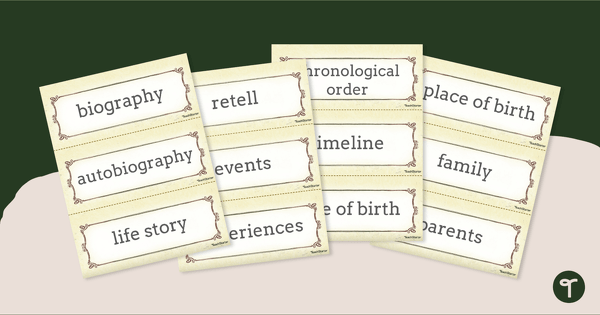
Biography vocabulary words are words associated with writing and understanding biographies. These words help to describe the life and accomplishments of a historical figure, artist, or other public figure. They include words like biography, autobiography, timeline, legacy, and influence. They are important to know when studying the life of someone in history or researching a current public figure. Knowing these words can help in understanding biographies more effectively and accurately.
Definition of Biography
Vocabulary Words
Biography is a detailed description of a person’s life, usually with the purpose of understanding their actions, motivations, and accomplishments. As such, there are certain vocabulary words associated with biographies that are important to know and understand in order to comprehend these stories. Here are some of the most common vocabulary words associated with biographical narratives and their definitions:
Anecdote: A short, entertaining story or account of an incident.
Biographer: A person who writes a biography, either as an occupation or as an author.
Context: The circumstances that form the setting of a particular event or conversation.
Epilogue: A brief concluding section to a book or play, typically expressing the moral or practical lesson to be learned.
Factoid: A brief or trivial item of news or information.
Impartial: Not biased or influenced by personal feelings or opinions in considering and representing facts.
Obituary: A notice of someone’s death, typically including a short biography.
Perspective: A particular attitude toward or way of considering a matter.
Reliable: Consistently trustworthy and accurate.
Significance: The quality of being worthy of attention; importance.
Timeline: A sequence of events in chronological order.
Types of Biographies
Biographies provide readers with a glimpse into the lives of some of the most influential people in history. While many biographies are written about historical figures, they can also be written about contemporary figures as well. Regardless of the subject, there are several types of biographies that can be written.
The most common type of biography is an autobiographical account, which is written by the subject of the biography themselves. Autobiographical biographies document the life of the writer in great detail, from their birth to their most recent accomplishments. Autobiographies are often written when the subject is of great importance or has achieved a certain level of success.
The second type of biography is a biographical account. These are written by an author who has researched the subject’s life, and is typically written when the subject has passed away. Biographical accounts provide readers with a comprehensive overview of the subject’s life, including any major accomplishments or significant events.
The third type of biography is a hagiography, which is a type of biography written with an emphasis on the subject’s idealized virtues and heroic deeds. Hagiographies are typically written about religious figures or influential people.
Finally, there is a biographical novel, which is a combination of a biography and a novel. Biographical novels use the facts of the subject’s life to create a fictional narrative, allowing the writer to create a more engaging and entertaining story.
No matter which type of biography you are writing, it’s important to remember that biographies should be informative, accurate, and engaging. While they may be based on the same subject, each type of biography has its own unique purpose and should be written accordingly.
Common Biography Vocabulary Words
Biographies are stories about people’s lives, and they’re often used to learn more about a person’s accomplishments, experiences, and personal attributes. When reading biographies, students should be aware of common biography vocabulary words that are used to describe the person’s character, achievements, and other aspects of their life. Knowing these words will help students understand biographies more easily.
Some of the most common words associated with biographies are “birth,” “death,” “education,” “career,” “accomplishments,” “influence,” “legacy,” “contributions,” and “family.” Other words that can be used to describe a person’s life include “achievements,” “influences,” “mentors,” “friends,” “experiences,” “travels,” and “hobbies.” All of these words can help give insight into the person’s life and accomplishments.
Learning common biography vocabulary words can help students better comprehend biographies and better understand the lives of individuals. By familiarizing themselves with these words, students can become better readers and gain a deeper understanding of the people they are learning about.
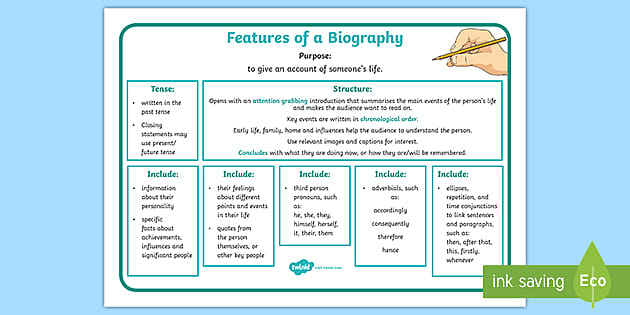
Examples of Biography Vocabulary in Context
Biographies provide readers with an in-depth look into the lives of people, their accomplishments, and their impact on society. To effectively convey the story of a person’s life, biography authors must use precise language to describe the events and individuals involved. To help these authors, there is a variety of biography-specific vocabulary words available. From words that describe people’s behavior to words that explain events, biography vocabulary words can help readers better understand the story of a person’s life.
To illustrate the importance of biography vocabulary, let’s take a look at some examples of biography words in context.
The term “milestone” is often used to describe an important event or achievement in a person’s life. For example, a biography about a scientist might discuss the “milestone” of their discovery of a new element.
The word “legacy” is used to describe the lasting impact that a person has had on their field or society in general. For example, a biography about a politician might discuss the “legacy” of their initiatives that are still in place today.
The phrase “formative years” is used to refer to the period of time when a person is learning and growing, usually during their childhood. For example, a biography about an author might discuss their “formative years” and how they shaped their writing style.
By using words like “milestone,” “legacy,” and “formative years,” biographers can provide readers with a comprehensive understanding of a person’s life. With the right vocabulary, biographers can help readers gain insight into the events and individuals that shaped a person’s life.
Tips for Learning Biography Vocabulary
Biography is a great way to understand the lives of historical figures, celebrities, and other influential people. But to comprehend the biographies you read, it’s important to know the vocabulary associated with them. To make the learning process easier, here are some tips for mastering biography vocabulary.
Firstly, start with the basics. Before diving into the more complex words associated with biographies, get to grips with the terms you’re most likely to come across. Get to know the language associated with biographies and familiarize yourself with the common biography vocabulary words.
Once you have the basics down, look into how biography vocabulary is used in context. Instead of just memorizing words, it’s important to understand the nuances of how they’re used. For example, a word can have a different meaning when used in a sentence or when used in a different field.
Additionally, it helps to have a system of practice. Flashcards are a great way to test your knowledge and commit words to memory. Similarly, reading biographies regularly and writing down the biography vocabulary words you come across will also help you remember them.
Finally, the best way to build your vocabulary is to talk about the words you’ve learned. Discussing the words and their definitions with other people is an effective way to cement them in your memory.
These tips are sure to help you boost your biography vocabulary. With a little bit of practice and patience, you’ll be able to read biographies with ease and understand the people and events that shaped history.
Biographies are an invaluable resource for learning about the lives of historical figures and the events that shaped them. Knowing key biography vocabulary words can help readers better understand biographies and the stories they tell. From the Latin word biographia, which means “the writing of life,” biographies offer readers a glimpse into the past and the people who lived it. Whether you’re reading a biography for pleasure or for research, understanding these key words can help you appreciate the story even more. With this knowledge, you’ll be able to better understand the language used in biographies, as well as the events and people described in them.
FAQs About the Biography Vocabulary Words
Q1: What is a “hagiography”? A1: A hagiography is a type of biography that focuses on the life of a particular saint, religious figure, or hero. The hagiography typically includes tales of miracles, heroic acts, and other examples of piety.
Q2: What is an “autobiography”? A2: An autobiography is a type of biography that is written by the subject themselves. It is a firsthand account of the life of the individual, and can include details of family, education, work, relationships, and other aspects of their life.
Q3: What is a “biopic”? A3: A biopic is a type of film or television program that is based on the life of a particular person. It is often used as a form of entertainment, but can also provide an insight into the life of a famous individual.
Biography vocabulary words are essential when discussing the life and work of a person. They provide a way to accurately describe the individual, their accomplishments, and their legacy. Knowing the right words to use when writing or speaking about someone’s life can help us to better understand and appreciate the individual’s story. With the right vocabulary, biographers can craft a story that will leave a lasting impression.
Related Posts

Reyna Love Biography

Raymond Cajuste Biography

Raven Hart Biography
Leave a reply cancel reply.
Your email address will not be published. Required fields are marked *
Save my name, email, and website in this browser for the next time I comment.
- Election 2024
- Entertainment
- Newsletters
- Photography
- Personal Finance
- AP Investigations
- AP Buyline Personal Finance
- AP Buyline Shopping
- Press Releases
- Israel-Hamas War
- Russia-Ukraine War
- Global elections
- Asia Pacific
- Latin America
- Middle East
- Election Results
- Delegate Tracker
- AP & Elections
- Auto Racing
- 2024 Paris Olympic Games
- Movie reviews
- Book reviews
- Personal finance
- Financial Markets
- Business Highlights
- Financial wellness
- Artificial Intelligence
- Social Media
Bill Walton, Hall of Fame player who became a star broadcaster, dies of cancer at 71
FILE - Basketball Hall of Fame legend Bill Walton laughs during a practice session for the NBA All-Star basketball game in Cleveland, Feb. 19, 2022. Walton, who starred for John Wooden’s UCLA Bruins before becoming a Basketball Hall of Famer and one of the biggest stars of basketball broadcasting, died Monday, May 27, 2024, the league announced on behalf of his family. He was 71. (AP Photo/Charles Krupa, File)
FILE - Basketball Hall of Fame legend Bill Walton, left, jokes with Denver Nuggets center Nikola Jokic during a practice session for the NBA All-Star basketball game in Cleveland, Feb. 19, 2022. Walton, who starred for John Wooden’s UCLA Bruins before becoming a Basketball Hall of Famer and one of the biggest stars of basketball broadcasting, died Monday, May 27, 2024, the league announced on behalf of his family. He was 71. (AP Photo/Charles Krupa, File)
FILE - Denver Nuggets’ Dan Issel, left, guards Portland Trail Blazers’ Bill Walton as Walton moves towards the basket during their game in Portland, Ore., Feb. 12, 1978. Walton, who starred for John Wooden’s UCLA Bruins before becoming a Basketball Hall of Famer and one of the biggest stars of basketball broadcasting, died Monday, May 27, 2024, the league announced on behalf of his family. He was 71. (AP Photo/Jack Smith, File)
FILE - UCLA center Bill Walton (32) shoots for two of his record 44 points against Memphis State in the final game of the NCAA college basketball tournament in St. Louis, March 26, 1973. Walton’s performance against Memphis State is still one of the greatest individual games in history. Walton, who starred for John Wooden’s UCLA Bruins before becoming a Basketball Hall of Famer and one of the biggest stars of basketball broadcasting, died Monday, May 27, 2024, the league announced on behalf of his family. He was 71. (AP Photo, File)
FILE - UCLA’s Bill Walton (32) fights Notre Dame’s Adrian Dantley (44) for a rebound during an NCAA college basketball game in South Bend, Ind., Jan. 19, 1974. Walton, who starred for John Wooden’s UCLA Bruins before becoming a Basketball Hall of Famer and one of the biggest stars of basketball broadcasting, died Monday, May 27, 2024, the league announced on behalf of his family. He was 71. (AP Photo, File)
FILE - Television analyst Bill Walton stretches before the first half of an NCAA college basketball game between Oregon and Colorado, Jan. 2, 2020, in Boulder, Colo. Walton, who starred for John Wooden’s UCLA Bruins before becoming a Basketball Hall of Famer and one of the biggest stars of basketball broadcasting, died Monday, May 27, 2024, the league announced on behalf of his family. He was 71. (AP Photo/David Zalubowski, File)
- Copy Link copied

Bill Walton was never afraid to be himself.
Larger than life, only in part because of his nearly 7-foot frame, Walton was a two-time NCAA champion at UCLA, a two-time champion in the NBA, a Basketball Hall of Fame inductee, an on-court icon in every sense of the word. And off the court, Walton was a chronic fun-seeker, a broadcaster who adhered to no conventional norms and took great joy in that, a man with a deeply serious side about the causes that mattered most to him.
“Bill Walton,” NBA Commissioner Adam Silver said, “was truly one of a kind.”
Walton died Monday at the age of 71 after a prolonged fight with cancer, the league announced on behalf of his family. He was the NBA’s MVP in the 1977-78 season, the league’s sixth man of the year in 1985-86 and a member of the league’s 50th anniversary and 75th anniversary teams. That followed a college career in which he blossomed while playing under coach John Wooden at UCLA, becoming a three-time national player of the year.
“I am sad today hearing that my comrade and one of the sports world’s most beloved champions and characters has passed,” Julius “Dr. J” Erving, a fellow Hall of Famer, wrote on social media. “Bill Walton enjoyed life in every way. To compete against him and to work with him was a blessing in my life.”
Tributes immediately began pouring in, and the NBA held a moment of silence to commemorate Walton’s life before Game 4 of the Boston Celtics-Indiana Pacers matchup in the Eastern Conference finals on Monday night.
Walton, who entered the Hall of Fame in 1993, was one of the game’s most celebrated figures. His NBA career — disrupted by chronic foot injuries — lasted only 468 games combined with the Portland Trail Blazers, the San Diego/Los Angeles Clippers and the Celtics. He averaged 13.3 points and 10.5 rebounds in those games, neither of those numbers exactly record-setting.
Still, his impact on the game was massive.
“I love him as a friend and as a teammate,” Celtics legend Larry Bird said. “It was a thrill for me to play with my childhood idol and together we earned an NBA championship in 1986. He is one of the greatest ever to play the game. I am sure that all of my teammates are as grateful as I am that we were able to know Bill. He was such a joy to know and he will be sorely missed.”
Walton’s most famous game was the 1973 NCAA title game, UCLA against Memphis, in which he shot 21 for 22 from the field and led the Bruins to another national championship.
“One of my guards said, ’Let’s try something else,’” Wooden told The Associated Press in 2008 for a 35th anniversary retrospective on that game.
Wooden’s response during that timeout: “Why? If it ain’t broke, don’t fix it.”
They kept giving the ball to Walton, and he kept delivering in a performance for the ages.
“It’s very hard to put into words what he has meant to UCLA’s program, as well as his tremendous impact on college basketball,” UCLA coach Mick Cronin said Monday. “Beyond his remarkable accomplishments as a player, it’s his relentless energy, enthusiasm for the game and unwavering candor that have been the hallmarks of his larger-than-life personality.
“It’s hard to imagine a season in Pauley Pavilion without him.”
When Walton retired from the NBA he turned to broadcasting, something he never thought he could be good at — and an avenue he sometimes wondered would be possible for him, because he had a pronounced stutter at times in his life.
Turns out, he was excellent at broadcasting: Walton was an Emmy winner, eventually was named one of the top 50 sports broadcasters of all time by the American Sportscasters Association and even appeared on The New York Times’ bestseller list for his memoir, “Back from the Dead.” It told the story of a debilitating back injury suffered in 2008, one that left him considering taking his own life because of the constant pain, and how he spent years recovering.
“I lived most of my life by myself. But as soon as I got on the court I was fine,” Walton told The Oregonian newspaper for a story published in 2017. “But in life, being so self conscious, red hair, big nose, freckles and goofy, nerdy looking face and can’t talk at all. I was incredibly shy and never said a word. Then, when I was 28 I learned how to speak. It’s become my greatest accomplishment of my life and everybody else’s biggest nightmare.”
The last part of that was just Walton hyperbole. He was known for his on-air tangents and sometimes appeared on-air in Grateful Dead T-shirts; Walton was a huge fan of the band and referenced it often, even sometimes recording satellite radio specials celebrating what it meant to be a “Deadhead.”
And the Pac-12 Conference, which has basically evaporated in many ways now because of college realignment, was another of his many loves. He always referred to it as the “Conference of Champions” and sang its praises all the way to the end.
“It doesn’t get any better than this,” he once said on a broadcast, tie-dyed T-shirt on, a Hawaiian lei around his neck.
Walton was involved in the broadcasts of college and NBA games for CBS, NBC and ABC/ESPN in his career, along with stints working for the Clippers and Sacramento Kings as an analyst. He returned to ESPN and the Pac-12 Network, further touting the roots of his league, in 2012.
“Bill Walton was a legendary player and a singular personality who genuinely cherished every experience throughout the journey of his extraordinary life,” ESPN Chairman Jimmy Pitaro said. “Bill often described himself as ‘the luckiest guy in the world,’ but anyone who had the opportunity to interact with Bill was the lucky one. He was a truly special, giving person who always made time for others. Bill’s one-of-a-kind spirit captivated and inspired audiences during his second career as a successful broadcaster.”
But Walton will always be synonymous with UCLA’s dominance.
He enrolled at the school in 1970, before freshmen could play on the varsity team. Once he could play for Wooden, the Bruins were unbeatable for more than two years — Walton’s UCLA teams won their first 73 games, the bulk of the Bruins’ extraordinary 88-game winning streak. It was snapped against Notre Dame in 1974, a 71-70 loss in which Walton shot 12 for 14 from the field.
“Bill Walton’s passing is a sad tragedy. One of the great ones in UCLA basketball history,” Digger Phelps, who coached that Notre Dame team, posted Monday on social media. “We were great friends over the years. It won’t be the same without him.”
UCLA went 30-0 in each of Walton’s first two seasons, and 86-4 in his career on the varsity team.
“My teammates … made me a much better basketball player than I could ever have become myself,” Walton said at his Hall of Fame speech in 1993. “The concept of team has always been the most intriguing aspect of basketball to me. If I had been interested in individual success or an individual sport, I would have taken up tennis or golf.”
Walton led Portland to the 1977 NBA title, then got his second championship with Boston in 1986.
“Bill Walton was an icon,” said Jody Allen, the chair of the Trail Blazers. “His leadership and tenacity on the court were key to bringing a championship to our fans and defined one of the most magical moments in franchise history. We will always treasure what he brought to our community and the sport of basketball.”
The Celtics released a statement saying: “Bill Walton was one of the most consequential players of his era. ... Walton could do it all, possessing great timing, complete vision of the floor, excellent fundamentals and was of one of the greatest passing big men in league history.”
Walton considered himself fortunate to have been guided by two of the game’s greatest minds in Wooden and Celtics patriarch Red Auerbach.
“Thank you John, and thank you Red, for making my life what it has become,” Walton said in his Hall of Fame speech.
Walton was the No. 1 pick by Portland in the 1974 draft. He said Bill Russell was his favorite player and referred to Bird as the toughest and best he played with, so it was appropriate that his playing career ended as a member of the Celtics. “Playing basketball with Larry Bird,” Walton once said, “is like singing with Jerry Garcia,” referencing the co-founder of the Grateful Dead.
In his final years, Walton spoke out about issues that mattered most to him, such as the problem of homelessness in his native San Diego , urging city leaders to take action and create shelter space to help those in need.
“What I will remember most about him was his zest for life,” Silver said in a statement. “He was a regular presence at league events — always upbeat, smiling ear to ear and looking to share his wisdom and warmth. I treasured our close friendship, envied his boundless energy and admired the time he took with every person he encountered.”
Walton died surrounded by his loved ones, his family said. He is survived by wife Lori and sons Adam, Nate, Chris and Luke — a NBA championship-winning player and now a coach.
Said Pacers coach Rick Carlisle, who was teammates with Walton in Boston: “He defiantly competed for every moment in life to be the greatest it could possibly be.”
AP NBA: https://apnews.com/hub/NBA

- Write an equation or formula Article
- Indent the first line of a paragraph Article
- Double-space the lines in a document Article
- Create a bibliography, citations, and references Article
- Insert footnotes and endnotes Article

Create a bibliography, citations, and references

Put your cursor at the end of the text you want to cite.
Go to References > Style , and choose a citation style.
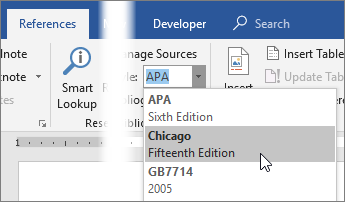
Select Insert Citation .
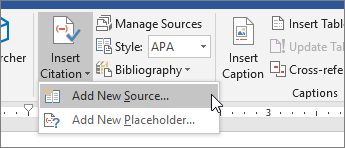
Choose Add New Source and fill out the information about your source.
Once you've added a source to your list, you can cite it again:
Go to References > Insert Citation , and choose the source you are citing.

To add details, like page numbers if you're citing a book, select Citation Options , and then Edit Citation .

Create a bibliography
With cited sources in your document, you're ready to create a bibliography.
Put your cursor where you want the bibliography.
Go to References > Bibliography , and choose a format.
Tip: If you cite a new source, add it to the bibliography by clicking anywhere in the bibliography and selecting Update Citations and Bibliography .

Need more help?
Want more options.
Explore subscription benefits, browse training courses, learn how to secure your device, and more.

Microsoft 365 subscription benefits

Microsoft 365 training

Microsoft security

Accessibility center
Communities help you ask and answer questions, give feedback, and hear from experts with rich knowledge.

Ask the Microsoft Community

Microsoft Tech Community

Windows Insiders
Microsoft 365 Insiders
Was this information helpful?
Thank you for your feedback.
Meet the editor who brought Julia Child to American kitchens
Judith Jones, a publishing pioneer who championed the publication of Child’s first cookbook and Anne Frank’s diary, is the subject of a new biography, “The Editor.”
In 2007, at the age of 83, the great book editor Judith Jones published a slim, sparkling memoir that danced over the major events of her life and publishing career, chiefly as related to cooking and cookbooks. Jones is best known — insofar as editors are known at all — for her momentous collaboration with Julia Child. “ The Tenth Muse: My Life in Food ” was sculpted with all the economy and finesse you would expect from a professional. Jones sketched her life in a series of bright, evocative vignettes: telling her prim mother that, yes, she really did like garlic; lunching on calves’ brains en cocotte with pianist/memoirist Arthur Rubinstein; arguing with an imperious Marcella Hazan over the fat content of a recipe (they weren’t buddies); skinning and frying a beaver’s tail (“I popped a glistening morsel into my mouth and was ravished”). The book perfectly captured Jones’s wit, moxie and appetite.
Culinary scholar Sara B. Franklin picked up a copy of “The Tenth Muse” as a college student and found it “fun,” but suspected there were shadowy corners of Jones’s life that had gone unexplored. A few years later, Franklin met and befriended Jones, confirmed that suspicion, and began taking notes on their conversations. In her discreet and deeply respectful new biography, “ The Editor: How Publishing Legend Judith Jones Shaped Culture in America ,” Franklin restores the “disappointments, hard choices, mistakes, and pain” that Jones omitted from her sunny memoir. Simultaneously, she tries to give a notoriously modest woman her due. As Franklin puts it: “Nowhere could I find a depiction of Judith that even suggested the reaches of her curiosity and sophistication, her complexity and acumen, her savvy and her guile.” With this book, she has righted that wrong.
Born in 1924, Jones grew up in a genteel Manhattan family where the women were, Franklin writes, “groomed their whole lives to climb the social ladder and become ladies of society.” A bookworm from childhood, Judith never conformed. She wanted a career, she wanted varied experiences, she wanted to eat garlic. Probably the spiciest revelation in the book comes early: Studying at Bennington College in the 1940s, Jones fell in love with one of her professors, the poet Theodore Roethke. In Franklin’s quaint verbiage, Jones was drawn to the “workings of his intellect and his big, hulking frame.” The pair would later “tangle in the sheets.”
The tangling ceased after Jones moved to Paris in 1948 and encountered cafe life, sole meunière and her future husband, Evan Jones. (“I just wanted to spend my life with this person!” Judith gushed to Franklin decades later.) She began working at Doubleday’s Paris office and made her first contribution to literary history. It was a doozy. Charged with typing “polite pass” letters for books on the rejection pile, she instead read one of them over the course of an afternoon and convinced her boss that he was wrong about “Anne Frank: The Diary of a Young Girl.” He sent the book to New York with an endorsement that didn’t mention Jones.
When she returned to New York, Jones took a job at Alfred A. Knopf, where she would work for the rest of her career. Franklin walks us through the many knockout hits, as well as a few misses. Jones pushed to publish Sylvia Plath’s first collection, “The Colossus,” though unaccountably turned down “The Bell Jar.” (Ironically, she envied Plath’s seemingly cozy domestic life.) She had long, sustaining professional relationships with John Updike, Anne Tyler — with whom she corresponded about a range of subjects, such as garden pests and print runs — and the poet Sharon Olds, who appreciated her “judgments, which were never unkind.” Her editing style, according to Tyler, was “very delicate and graceful, almost weightless.”
Naturally, Franklin devotes abundant real estate to Jones’s work on cookbooks, especially her relationship with Julia Child, which began in 1959. Knowing that Jones liked to cook, a colleague handed her a “thick, unwieldy stack of paper” that he assumed she would reject. Jones took it home in chunks and, following its recipe for boeuf bourguignon , made the best version of that dish she’d ever tasted. She went to bat for the book — and the rest really is history. What Franklin supplies here is context: At the time, cookbooks in the United States were “patronized, written off, or altogether ignored.” Jones changed that. She and Child both saw “cooking as a gateway to the wider world and a richer, more autonomous life,” and so, now, do many of us. Jones went on to nurture writers whose works line the shelves of American cooks to this day: Madhur Jaffrey, Claudia Roden, Joan Nathan and Edna Lewis, to name but a few.
So what were the struggles that Jones left out of the memoir? Franklin describes Jones’s conflicts with her boss, the legendary Robert Gottlieb, who comes off to her as a boor. He seems to have disdained Jones’s modesty, belittled her contributions, taken credit for her work and denied her only request for a raise. But the overarching sorrow of Jones’s life was, in Franklin’s telling, her infertility. Although she was close to her stepdaughters and later adopted the older children of family friends, she had badly wanted children of her own. None of this is unusual or dramatic except insofar as it shows that Jones, like everyone, had demons to battle and obstacles to surmount. That friction — absent from her memoir — makes her accomplishments all the more impressive.
While Jones’s memoir is a quicker, more effervescent read, Franklin, a loyal amanuensis, has filled in the holes, restored the cultural context and talked up the triumphs in an extraordinary life.
Jennifer Reese, the author of “Make the Bread, Buy the Butter,” is a freelance writer and critic.
How Publishing Legend Judith Jones Shaped Culture in America
By Sara B. Franklin
Atria. 336 pp. $29.99
More from Book World
Love everything about books? Make sure to subscribe to our Book Club newsletter , where Ron Charles guides you through the literary news of the week.
Check out our coverage of this year’s Pulitzer winners: Jayne Anne Phillips won the fiction prize for her novel “ Night Watch .” The nonfiction prize went to Nathan Thrall, for “ A Day in the Life of Abed Salama .” Cristina Rivera Garza received the memoir prize for “ Liliana’s Invincible Summer .” And Jonathan Eig received the biography prize for his “ King: A Life .”
Best books of 2023: See our picks for the 10 best books of 2023 or dive into the staff picks that Book World writers and editors treasured in 2023. Check out the complete lists of 50 notable works for fiction and the top 50 nonfiction books of last year.
Find your favorite genre: Three new memoirs tell stories of struggle and resilience, while five recent historical novels offer a window into other times. Audiobooks more your thing? We’ve got you covered there, too . If you’re looking for what’s new, we have a list of our most anticipated books of 2024 . And here are 10 noteworthy new titles that you might want to consider picking up this April.
We are a participant in the Amazon Services LLC Associates Program, an affiliate advertising program designed to provide a means for us to earn fees by linking to Amazon.com and affiliated sites.


COMMENTS
Personal Biography Template. A personal biography template is a structured outline designed to guide individuals in documenting their life stories, achievements, and experiences. It provides a framework to organize personal details in a coherent and engaging manner. This template, created in our prior response, can assist users by simplifying ...
A biography is the story of someone's life as written by another writer. Most biographies of popular figures are written years, or even decades, after their deaths. Authors write biographies of popular figures due to either a lack of information on the subject or personal interest. A biography aims to share a person's story or highlight a ...
We are providing up to 15 different biography templates available for immediate use. All of these biography templates are beautifully done and professionally designed in order to create a perfectly written biography. These templates come with gorgeous page designs and border designs. Using our templates, you'll have no problem filling in the ...
Depending on your primary focus and purpose of the biography, your word count can vary. Suppose you are writing your personal bio from an SEO perspective. Then the more the words, the better. If you are writing your personal biography on a resume or job-search site such as LinkedIn, keep your word count between 300-600 words.
A biography is simply an account of someone's life written by another person. A biography can be short in the case of few sentences biography, and it can also be long enough to fill an entire book. The short biographies explain a person's basic life facts and their importance, but the long biographies would go […]
Download Templates in MS Word Format. Download our professionally designed Personal Biography Templates in MS Word format today and embark on a journey of self-expression and professional growth. Unlock your potential, amplify your story, and make a lasting impact with our meticulously crafted templates.
Conduct relevant interviews. Whenever possible, seek firsthand accounts from those who knew or interacted with the subject. Conduct interviews with family members, friends, colleagues, or experts in the field. Their insights and anecdotes can provide a deeper understanding of the person's character and experiences.
Whether you want to start writing a biography about a famous person, historical figure, or an influential family member, it's important to know all the elements that make a biography worth both writing and reading. Biographies are how we learn information about another human being's life. Whether you want to start writing a biography about ...
30 Professional Biography Examples (& Templates) March 30, 2021 6 Mins Read. A biography is a written depiction of the life of a person that includes factual stories and details from their personal lives along with their successes, trials, and failures. Most of us have read biography examples of famous personalities, especially those we admire.
1. Go for a chronological structure. Start chronologically from the subject's birth to their death or later life. Use the timeline of the person's life to structure the biography. Start with birth and childhood. Then, go into young adulthood and adulthood.
2. Introduce yourself… like a real person. This is one of the most important pieces of understanding how to write a personal biography. Always start with your name. When many people start learning how to write a bio, they skip this important part. People need to know who you are before they learn what you do.
A biography template is basically an account of someone's life that is composed by another person. In the case of few sentences biography, a biography can be short. On the other hand, it can also be long enough just like an entire book. The short biographies demonstrates someone's basic life facts and their importance, while the long ...
Facebook. These are just some of the story elements you can use to make your biography more compelling. Once you've finished your manuscript, it's a good idea to ask for feedback. 7. Get feedback and polish the text. If you're going to self-publish your biography, you'll have to polish it to professional standards.
A Professional Biography Template provides a structured format to detail an individual's career journey, accomplishments, and personal story, ensuring a coherent and engaging narrative. We've crafted this template to simplify your experience, and it's readily available for you in Word and Google Docs. About this Template.
The Brief Biography Word Template is one of the simplest and most beautiful templates available for easy download. The template includes a lot of general guidelines and things that are important and should be kept in mind while writing a biography. IEEE Biography Template Word File Download. info-optim.ro. Details.
BIOGRAPHY WRITING Tip: #4 Put Something of Yourself into the Writing. While the defining feature of a biography is that it gives an account of a person's life, students must understand that this is not all a biography does. Relating the facts and details of a subject's life is not enough.
Use the best editable biography templates to gather information for your journalistic, literary, or research projects. Enter our online editor now and download your personalized biography template in seconds! Design a free creative Biography template. Engage your students to discover the power of synthesis and learn about the lives of famous ...
A biography (BYE-og-ruh-fee) is a written account of one person's life authored by another person. A biography includes all pertinent details from the subject's life, typically arranged in a chronological order. The word biography stems from the Latin biographia, which succinctly explains the word's definition: bios = "life" + graphia = "write."
biography: [noun] a usually written history of a person's life.
The biography of a word. This talk was presented by Jessie Fry, OED Associate Editor, Oxford Languages, to Professor Paige Gray's class of Liberal Arts and Writing at the Savannah College of Art and Design, and covered: the anatomy of an OED entry - where to find information on etymology, and the evolution of meaning through quotations.
BIOGRAPHY meaning: 1. the life story of a person written by someone else: 2. the life story of a person written by…. Learn more.
Biography vocabulary words are words associated with writing and understanding biographies. These words help to describe the life and accomplishments of a historical figure, artist, or other public figure. They include words like biography, autobiography, timeline, legacy, and influence. They are important to know when studying the life of someone in history or researching a […]
Walton's performance against Memphis State is still one of the greatest individual games in history. Walton, who starred for John Wooden's UCLA Bruins before becoming a Basketball Hall of Famer and one of the biggest stars of basketball broadcasting, died Monday, May 27, 2024, the league announced on behalf of his family. He was 71.
Create a bibliography. With cited sources in your document, you're ready to create a bibliography. Put your cursor where you want the bibliography. Go to References > Bibliography, and choose a format. Tip: If you cite a new source, add it to the bibliography by clicking anywhere in the bibliography and selecting Update Citations and Bibliography.
Judith Jones, a publishing pioneer who championed the publication of Child's first cookbook and Anne Frank's diary, is the subject of a new biography, "The Editor.". Review by Jennifer ...
At the end of the third quarter, Clark interviewed with ESPN and replied in six words to the dirty foul, saying, "That's just not a basketball play." "That's just not a basketball play. But, you ...
CNN —. After years of being off the radar, Michael Richards appears to be reemerging. In an interview with People ahead of the release next month of his memoir "Entrances and Exits," the ...